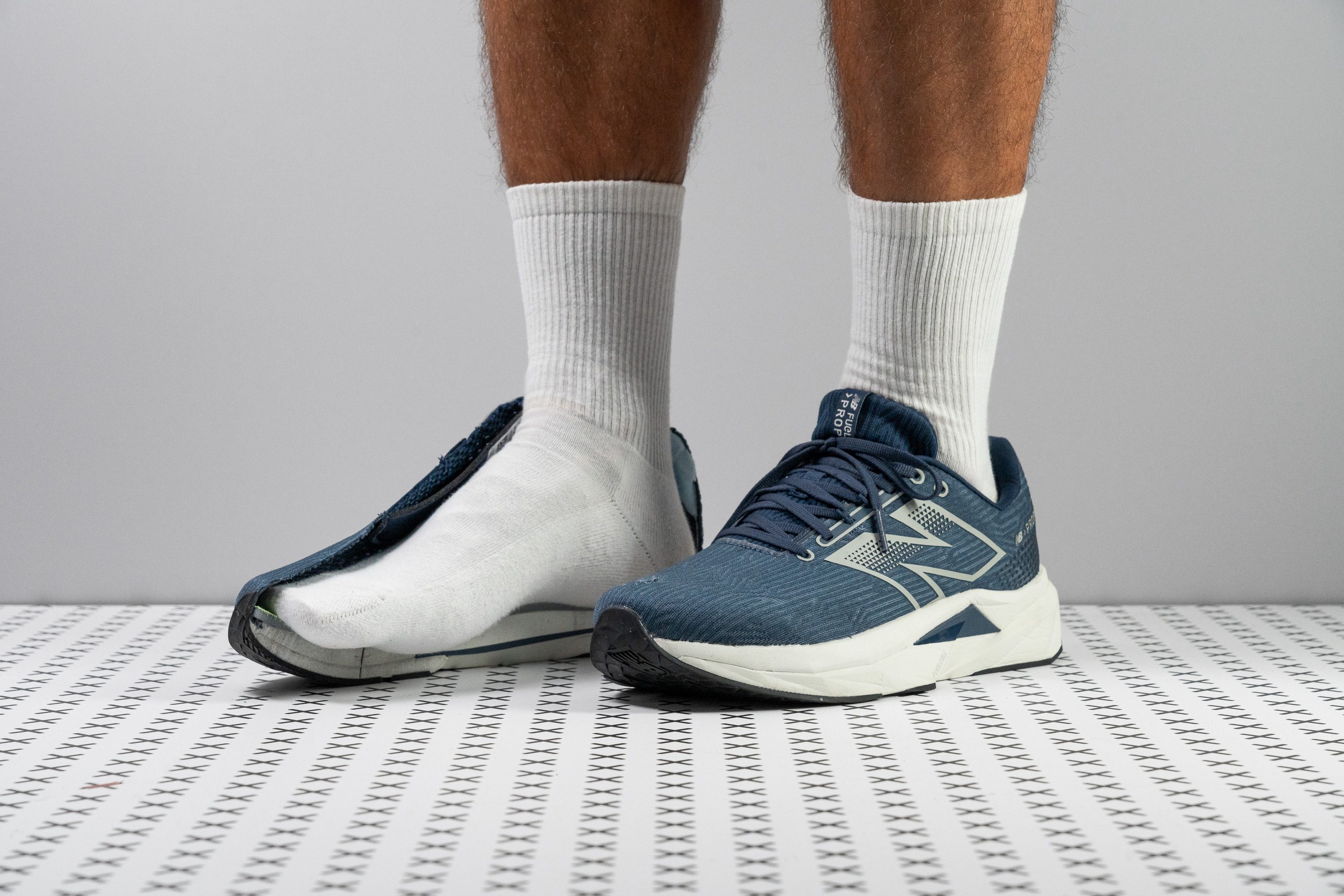Our verdict
Pros
- Exceptionally plush FuelCell midsole
- Highly breathable upper
- Stability-focused TPU plate
- Ideal for midfoot strikers
- Suitable for daily wear too
- Works for tempo training
- More affordable than similar models
- Keeps losing weight
Cons
- Poor durability
- Not the best for heel strikers
- Outsole prone to trapping small rocks
- Outsole prone to trapping small rocks
Audience verdict
Comparison
The most similar running shoes compared
+ + Add a shoe | |||||
|---|---|---|---|---|---|
| Audience score | 80 Good! | 89 Great! | 89 Great! | 84 Good! | |
| Price | £120 | £120 | £130 | £110 | |
| Pace | Daily runningTempo | Daily running | Daily running | Daily running | |
| Shock absorption | High | High | Moderate | Moderate | |
| Energy return | Moderate | Low | Moderate | Moderate | |
| Traction | Moderate | Moderate | Moderate | High | |
| Arch support | Neutral | Neutral | Neutral | Neutral | |
| Weight lab Weight brand | 9.5 oz / 269g 9.7 oz / 275g | 9.7 oz / 274g 9.5 oz / 270g | 10.1 oz / 285g 9.8 oz / 277g | 9.2 oz / 261g 9.5 oz / 268g | |
| Drop lab Drop brand | 6.7 mm 6.0 mm | 10.5 mm 5.0 mm | 7.0 mm 6.0 mm | 7.8 mm | |
| Strike pattern | Mid/forefoot | Heel | HeelMid/forefoot | Mid/forefoot | |
| Size | Slightly small | True to size | True to size | Slightly small | |
| Midsole softness | Soft | Soft | Balanced | Soft | |
| Difference in midsole softness in cold | Normal | Normal | Normal | Normal | |
| Toebox durability | Bad | Bad | Decent | Good | |
| Heel padding durability | Bad | Decent | Decent | Good | |
| Outsole durability | Decent | Good | Bad | Good | |
| Breathability | Breathable | Breathable | Moderate | Breathable | |
| Width / fit | Medium | Medium | Medium | Medium | |
| Toebox width | Medium | Medium | Medium | Medium | |
| Stiffness | Moderate | Moderate | Moderate | Flexible | |
| Torsional rigidity | Moderate | Stiff | Moderate | Flexible | |
| Heel counter stiffness | Moderate | Stiff | Moderate | Moderate | |
| Rocker | ✗ | ✗ | ✓ | ✗ | |
| Heel lab Heel brand | 35.2 mm 37.0 mm | 40.7 mm 40.0 mm | 36.8 mm 31.0 mm | 35.4 mm | |
| Forefoot lab Forefoot brand | 28.5 mm 31.0 mm | 30.2 mm 35.0 mm | 29.8 mm 25.0 mm | 27.6 mm | |
| Widths available | NormalWide | NormalWide | Normal | NormalWideX-Wide | |
| Orthotic friendly | ✓ | ✓ | ✓ | ✓ | |
| Season | SummerAll seasons | SummerAll seasons | All seasons | SummerAll seasons | |
| Removable insole | ✓ | ✓ | ✓ | ✓ | |
| Ranking | #304 Bottom 18% | #101 Top 28% | #85 Top 23% | #237 Bottom 36% | |
| Popularity | #190 Bottom 48% | #242 Bottom 34% | #256 Bottom 30% | #29 Top 8% |
Who should buy
We believe that the New Balance FuelCell Propel v5 is:
- Amazing for runners seeking a plush, cloud-like experience without breaking the bank—especially suited for those with a midfoot striking pattern.
- Perfect for fans of New Balance's current geometrical design looking for an effective daily trainer with an attractive price tag.
- Ideal as an all-in-one shoe, because it performs well across various distances and paces, from easy long runs to demanding uptempo workouts.

Who should NOT buy
Additionally, we've concluded that the toebox of the Propel v5 can be a significant drawback for those who prefer a roomier fit. For roomier options, we suggest considering the Adidas Adizero SL2 or the New Balance FuelCell Rebel v4, which offer a more spacious toebox and enhanced stability as a side benefit.
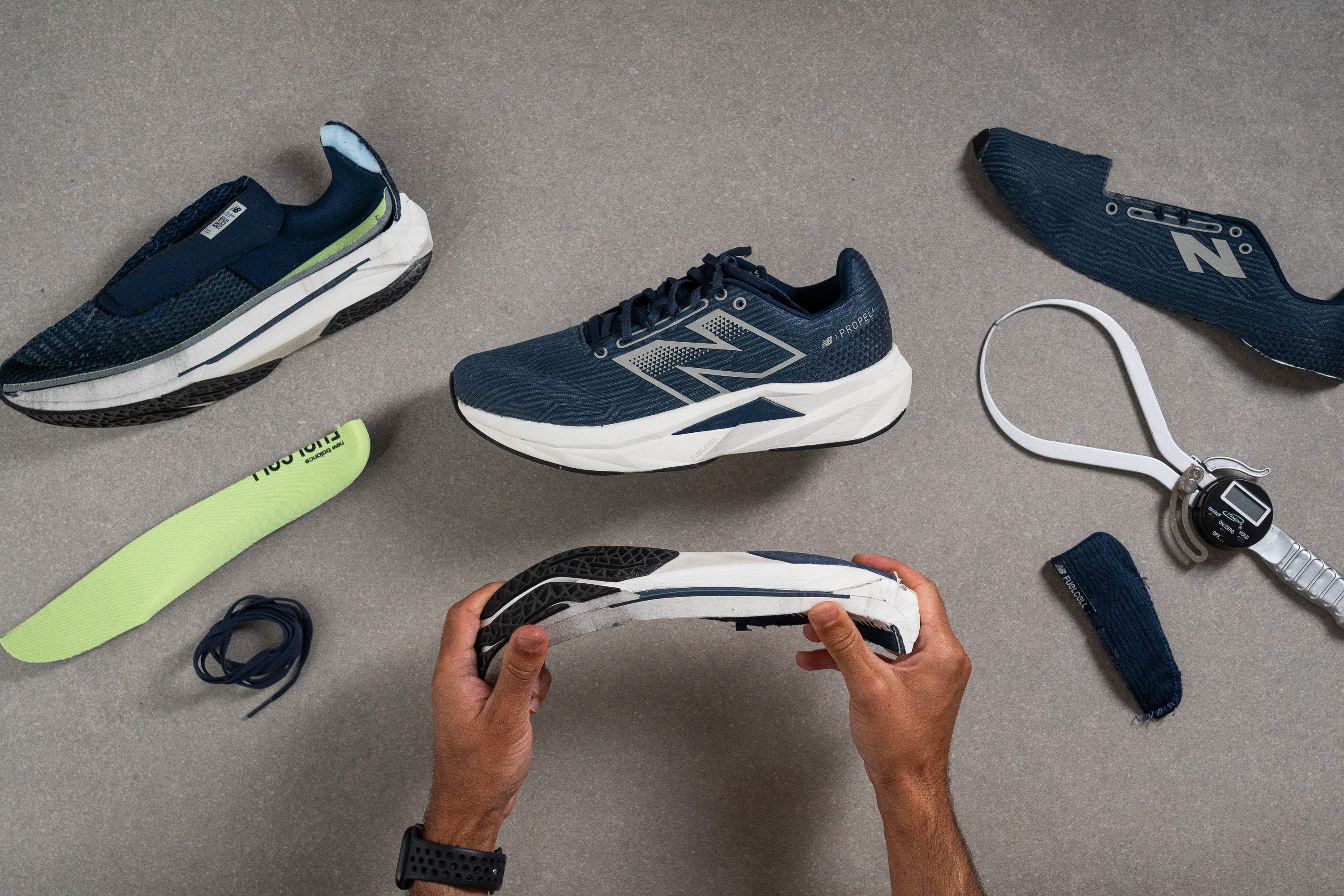
Cushioning
Shock absorption
We were impressed by the impact dampening in the previous Propel, and version 5 takes it a step further with even greater shock absorption. This makes it a standout choice for long runs on a budget, while still performing well for short efforts too.
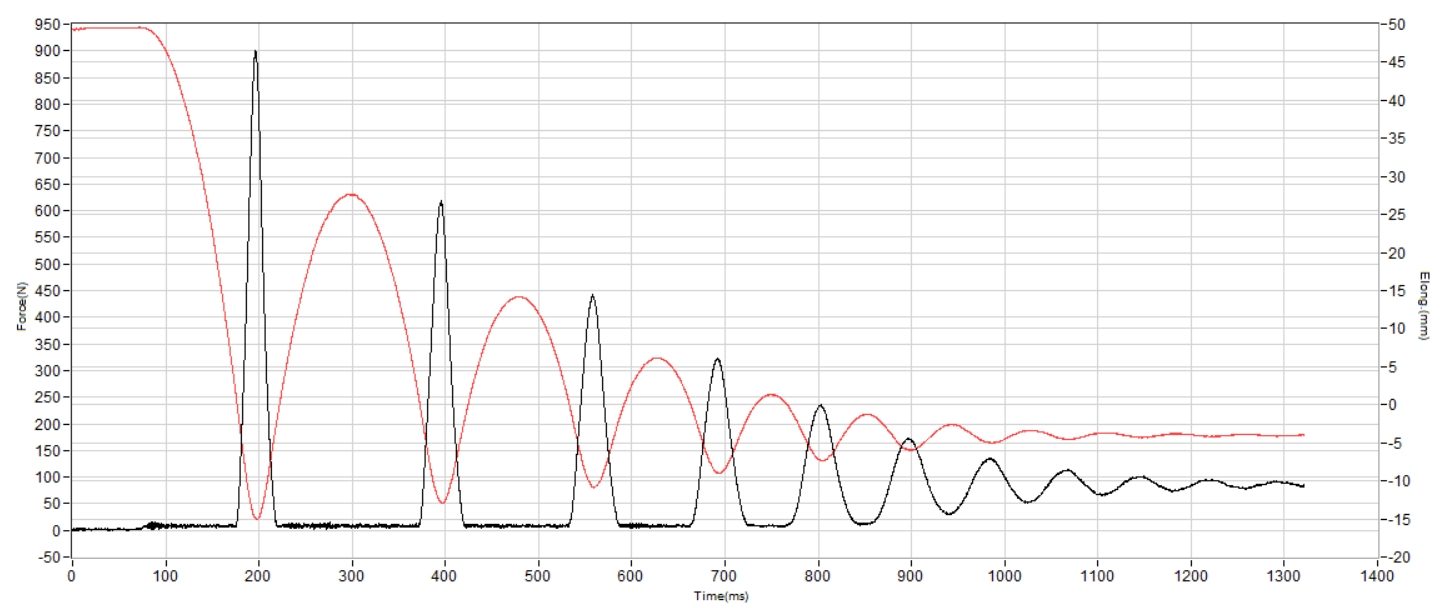
| FuelCell Propel v5 | 143 SA |
| Average | 129 SA |
Energy return
Since the midsole remains unchanged from the previous version, it delivered nearly identical energy return numbers. We measured 58.2% in the heel and 62.5% in the forefoot—right around average, but quite impressive considering the budget-friendly price.
| FuelCell Propel v5 | 58.2% |
| Average | 58.5% |
Heel stack
The Propel v5 boasts a heel cushion measured at 35.2 mm, offering a level of comfort that rivals much more expensive shoes.
This generous padding provides robust protection against the ground, making it suitable even for runners with a heavier build. We've tested this during multiple runs and can confirm that its cushioning does not fall short even after 10 miles.

| FuelCell Propel v5 | 35.2 mm |
| Average | 34.8 mm |
Forefoot stack
The Propel v5 boasts a 28.5 mm cushion in the forefoot, ideal for runners tackling any distance, particularly forefoot and midfoot strikers. Therefore, we confirmed that this model provides above-average cushioning in the forefoot too.
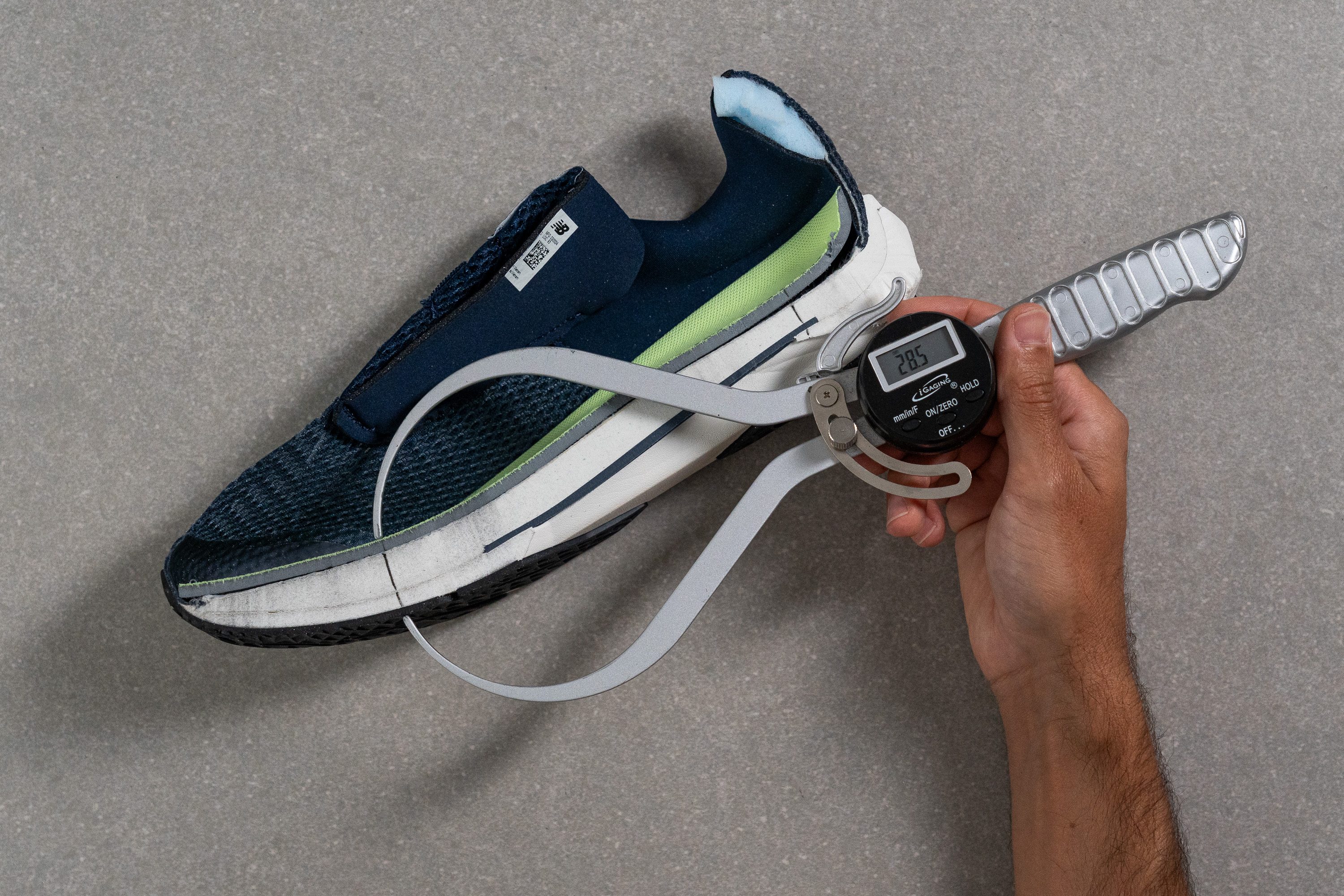
| FuelCell Propel v5 | 28.5 mm |
| Average | 26.2 mm |
Drop
We calculated the shoe's drop to be 6.7 mm from our previous measurements, closely mirroring New Balance's stated 6 mm drop, which checks out perfectly on our end.
As we said before, the Propel v5 design makes it exceptionally well-suited for midfoot strikers, not only due to its medium drop but also because of the specific plate design we're about to discuss!
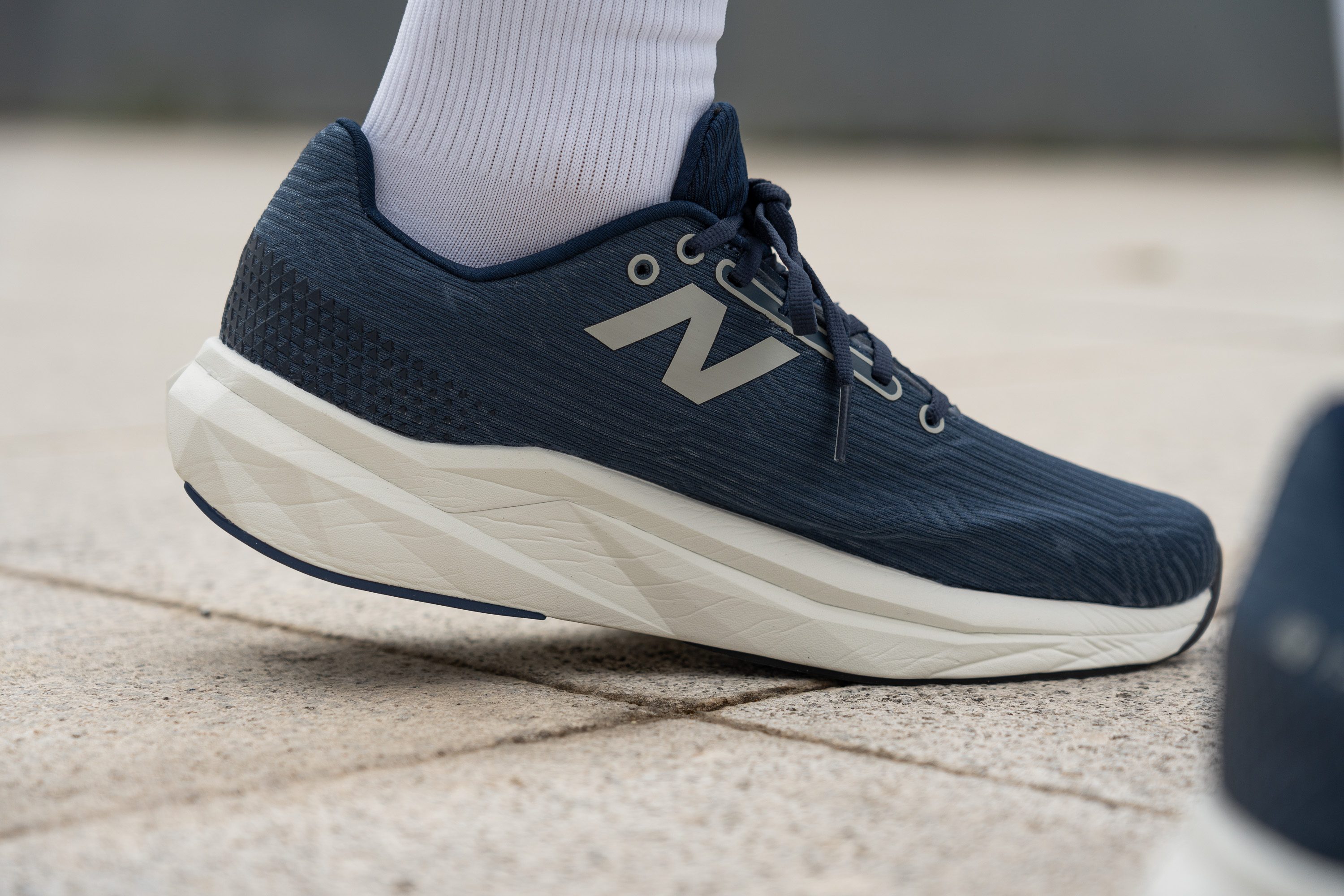
| FuelCell Propel v5 | 6.7 mm |
| Average | 8.6 mm |
Midsole softness
Over recent years, it has become clear that New Balance is aiming to carve out a niche for itself by offering plush midsoles in road running shoes, even in their more budget-friendly options.
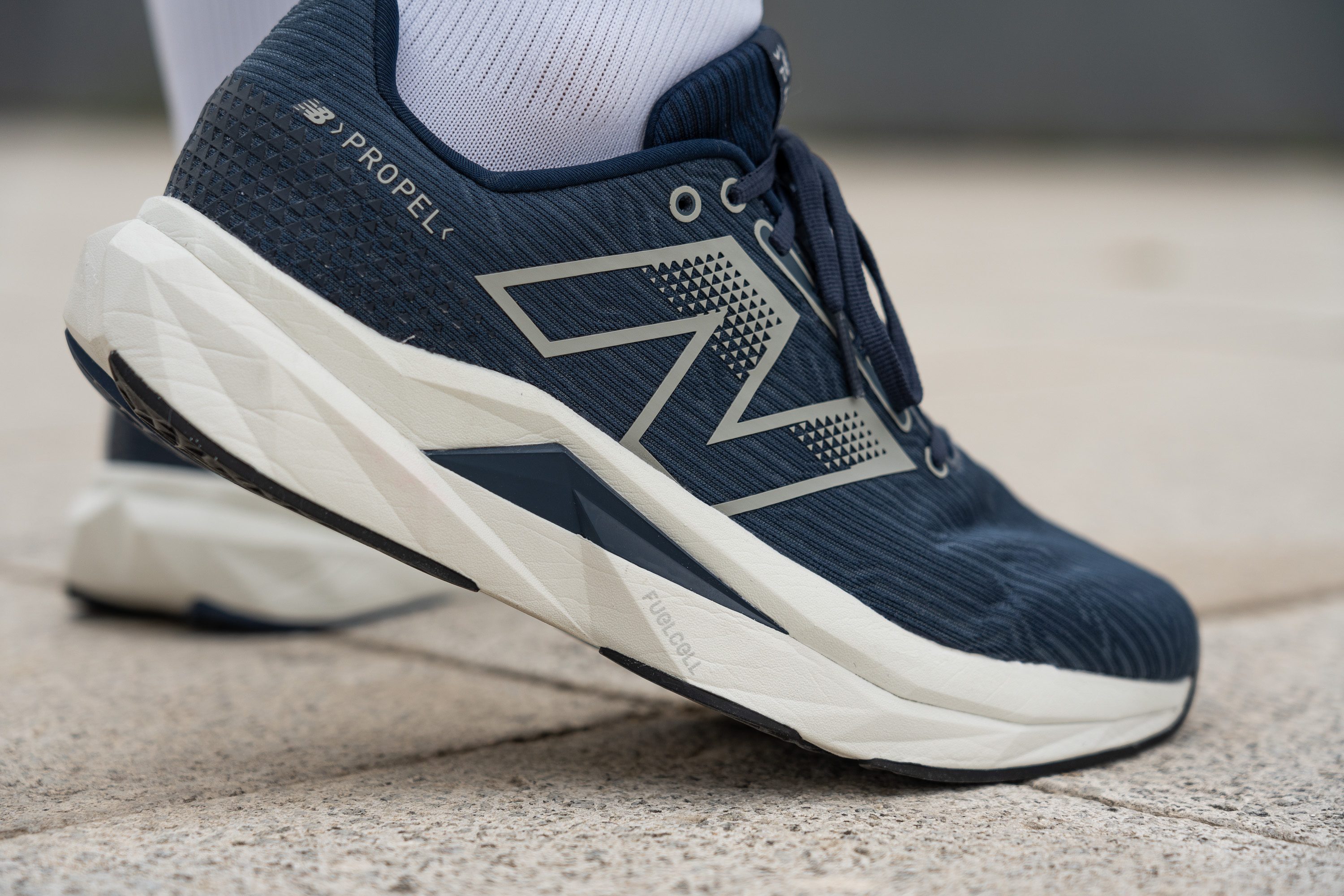
The Propel v5 is a prime example of this strategy, and it excels impressively in this regard, sporting the most favourable price-to-softness ratio we've encountered, with a durometer reading of just 9.8 HA.
Is this high level of softness good for you? We don't know. While many believe that softer means better, there can be major drawbacks too. For example, excessively soft midsoles might lead to increased stress on hips and knees and could demand more energy from the runner's legs if the foam does not rebound efficiently.
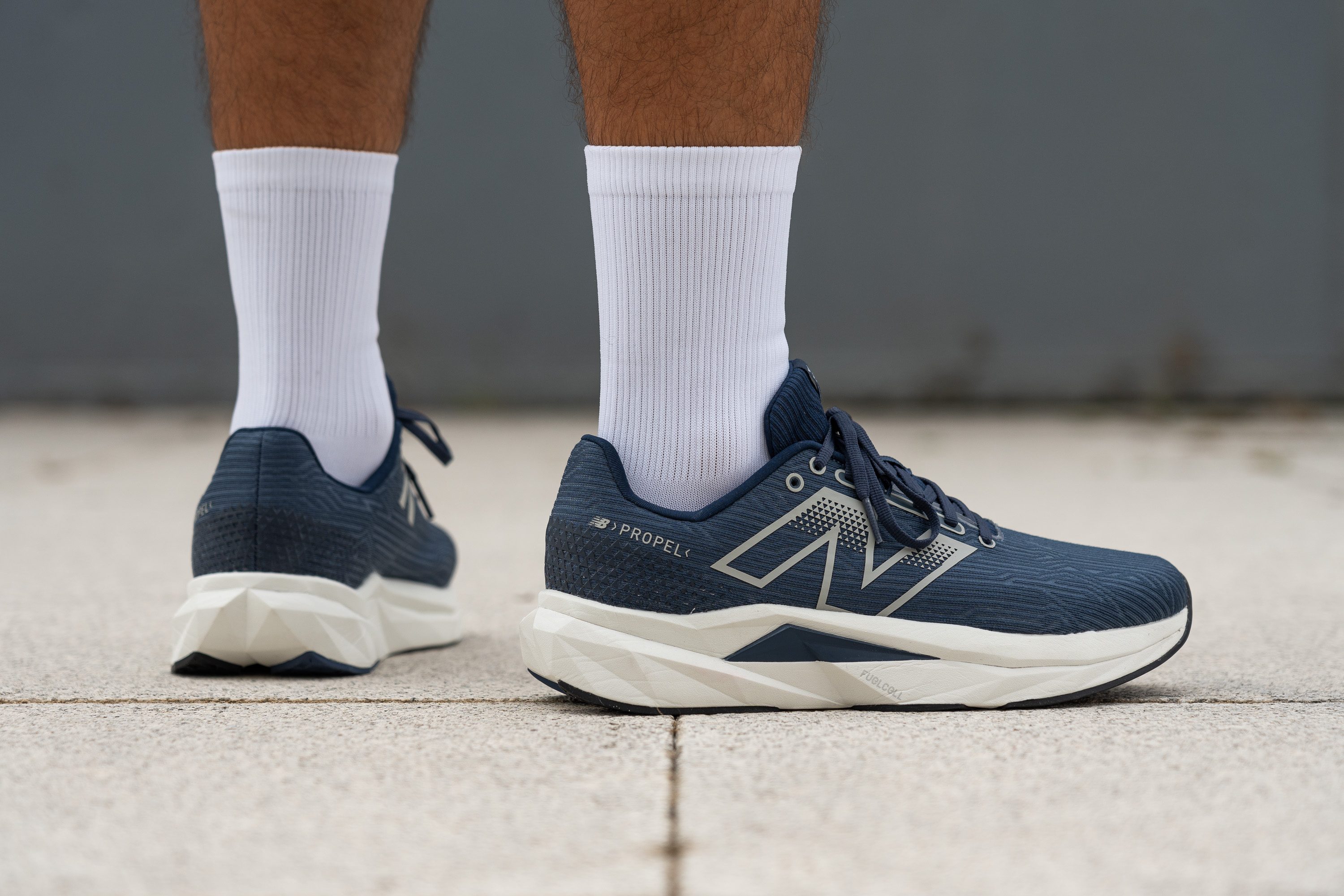
This specific formulation of FuelCell, designed to reduce costs and enhance affordability, does not offer extraordinary energy return. However, from our analysis, we consider it still surpass most EVA-based competitors in its price range.
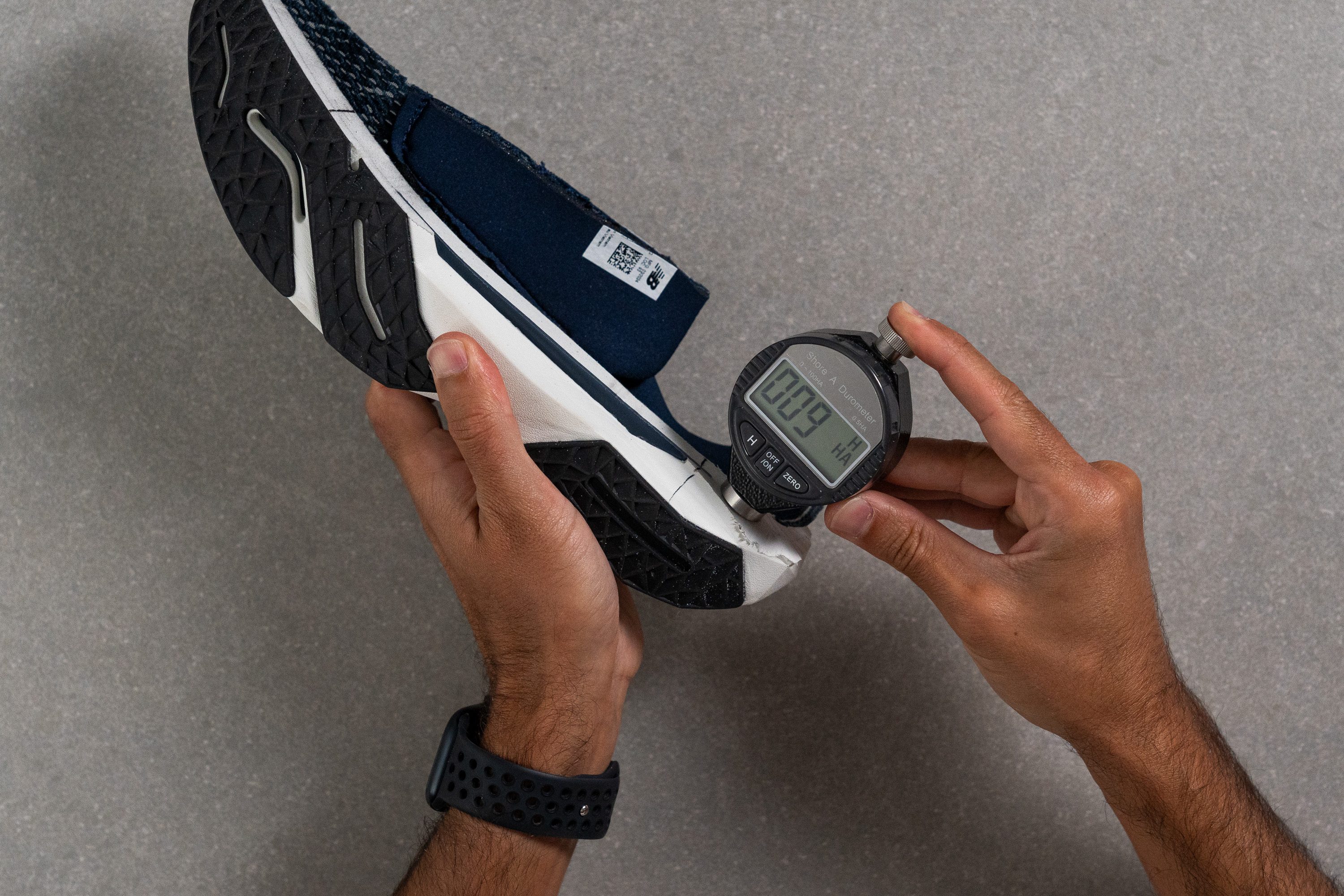
| FuelCell Propel v5 | 9.8 HA |
| Average | 20.4 HA |
Rocker
The early-stage rocker of the Propel v5 is subtly integrated, providing just enough lift to complement its moderate stack height.
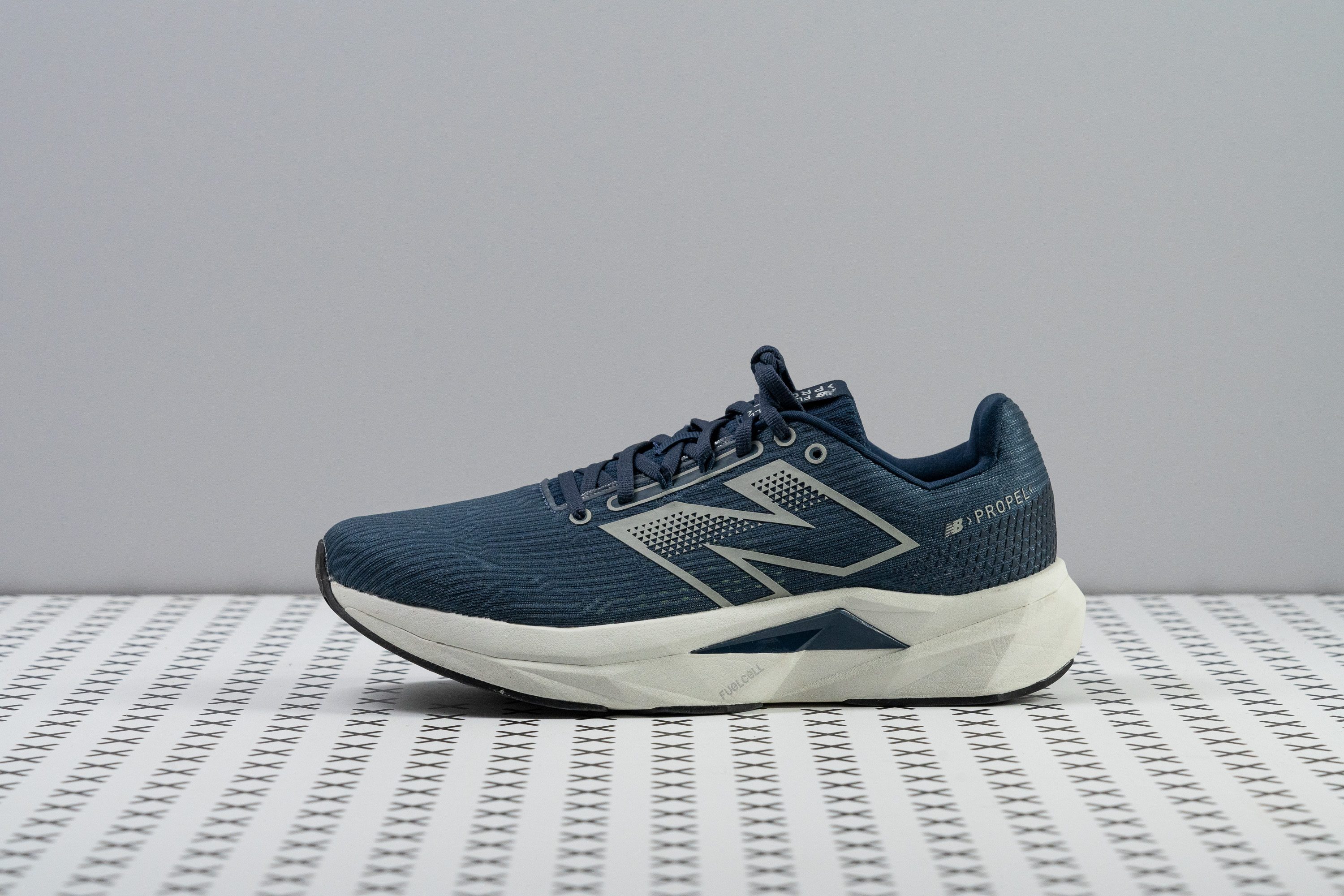
This Pegasus-like curvature suits the shoe well, offering a balanced ride that enhances the overall running experience. We believe this is an effective approach for this type of versatile daily trainer.
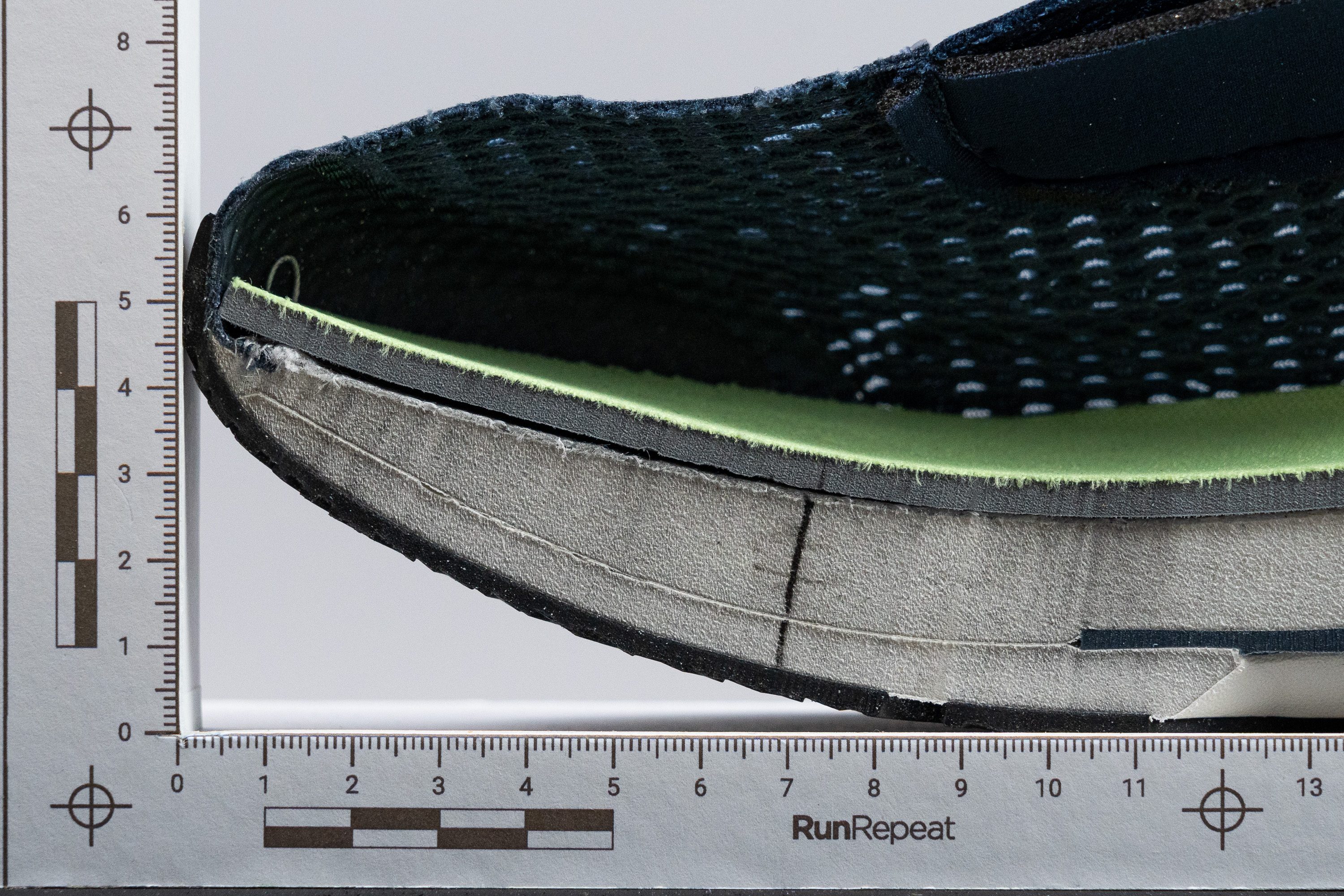
Plate
New Balance has continued the plate design from v4 in the Propel v5, featuring a partial length that stops at the ball of the foot. This design suits heel strikers well, aiding their transition to toe-off. However, we think the plate’s effectiveness is not a big deal.
Made from highly flexible TPU, the plate's impact on the ride is minimal. While it does offer slight stabilisation and aids in transitions, it's also noticeable and somewhat diminishes comfort during slow, easy runs.

Size and fit
Size
New Balance FuelCell Propel v5 fits slightly small (77 votes).
Width / Fit
There weren't any surprises with the fit of the Propel v5 but it didn't seem particularly roomy either. The only way to check its real dimensions was, of course, creating the mould of the shoe's interiors using gel.
Once the mould was ready to use, we measured its widest area with a digital calliper. At 93.1 mm, it proved to be slightly narrower than average but not enough to put it into the narrow bunch. People with medium-to-narrow feet are most likely to experience the best fit in this NB shoe but if you need more room for the toes, be sure to get the wide option.
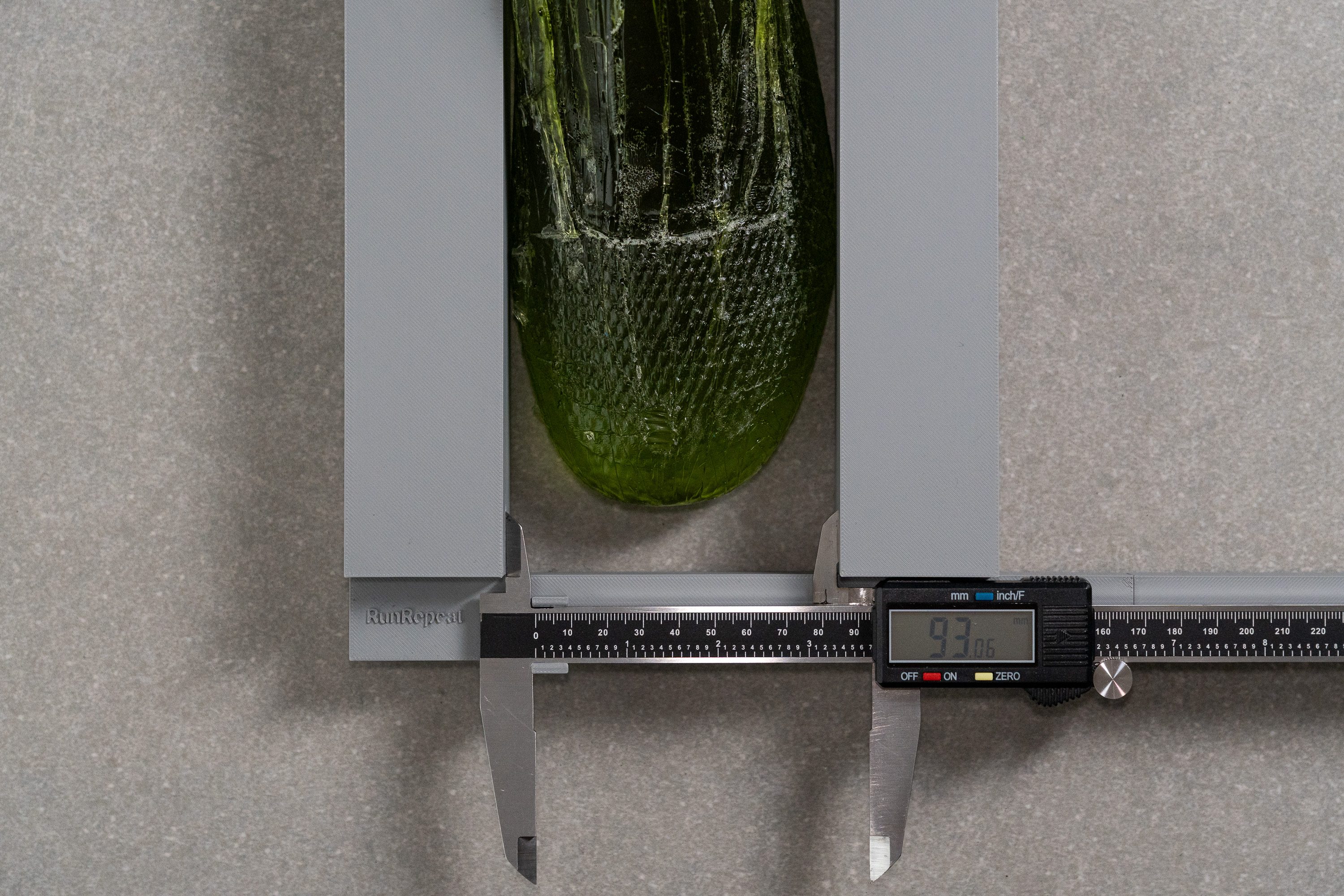
| FuelCell Propel v5 | 93.1 mm |
| Average | 95.1 mm |
Toebox width
The shoe has a fairly rounded, not-so-aggressively tapered shape which is reflected in our second measurement - toebox width. Clocking in at 73.9 mm, it is on par with the category average.
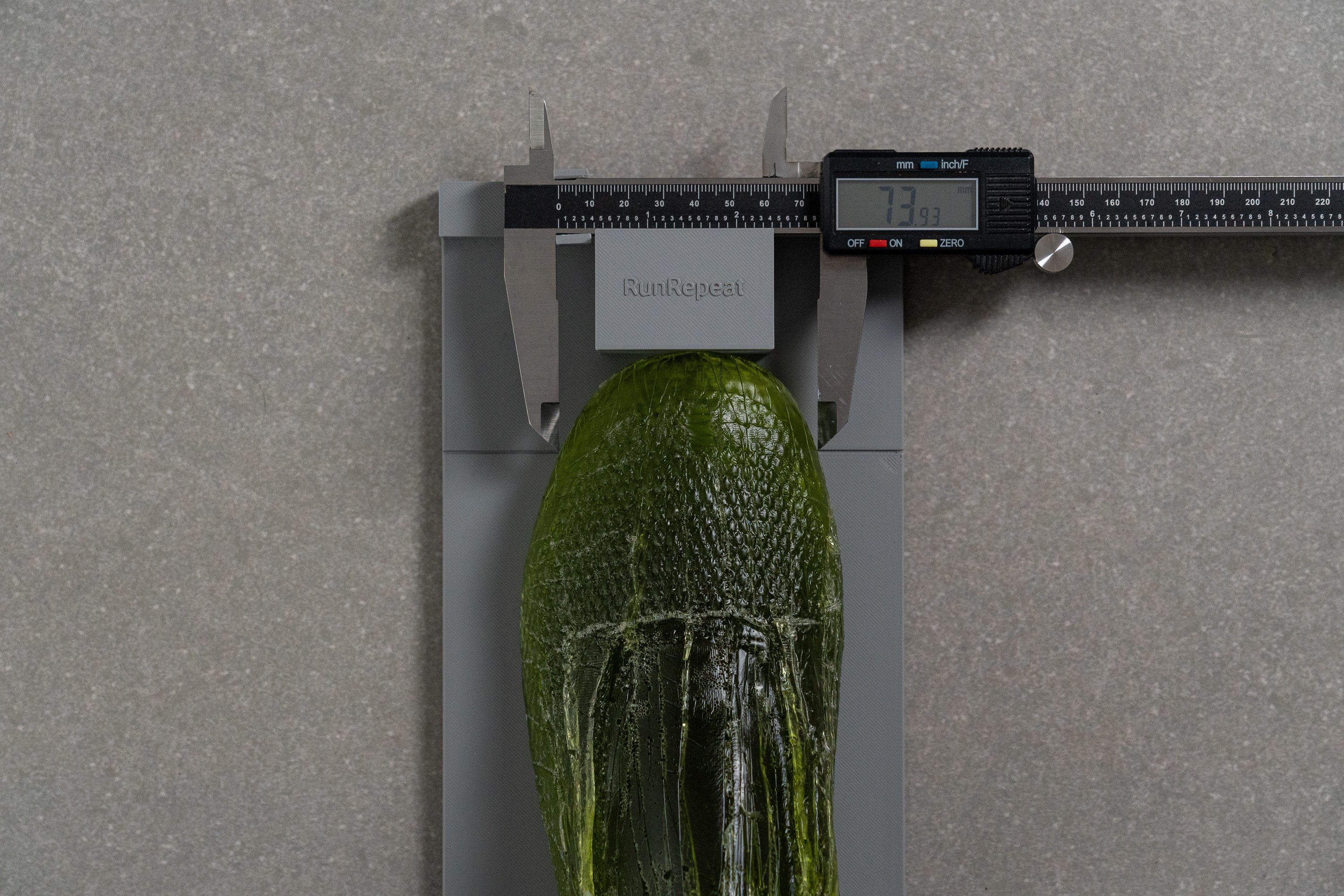
| FuelCell Propel v5 | 73.9 mm |
| Average | 73.3 mm |
Toebox height
The shoe's vertical space also proved to be adequate with enough room for an ample toe splay.
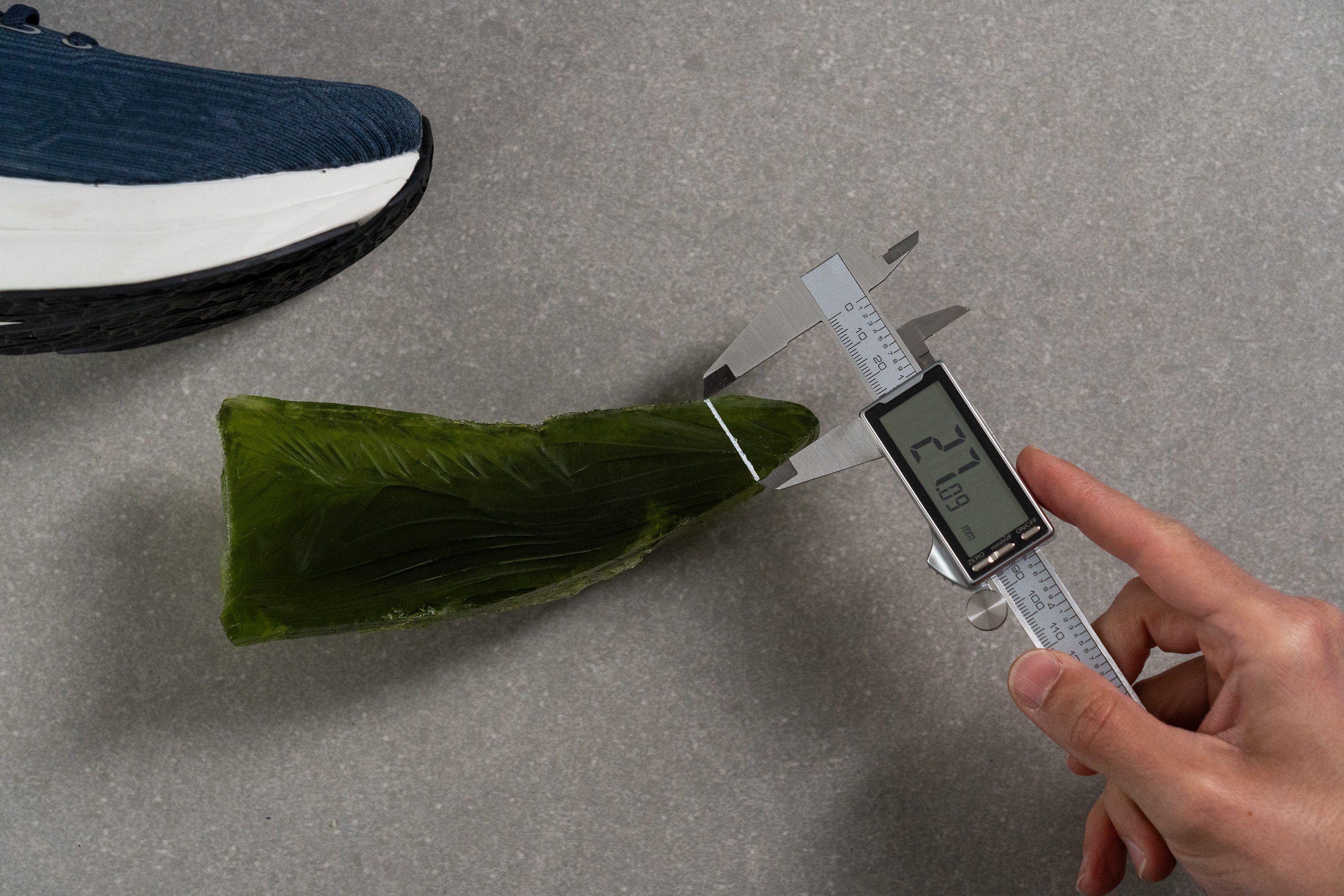
Our calliper recorded a standard toebox height of 27.1 mm in this New Balance shoe.
| FuelCell Propel v5 | 27.1 mm |
| Average | 27.1 mm |
Traction / Grip
Traction test
We tested the Propel v5 in the lab and recorded a 0.42 in our traction lab—a respectable figure for a non-premium model. The grip on dry pavement felt confident throughout, offering a secure foundation for everyday use on average road surfaces. Even in mildly slippery settings, this outsole will keep up without major issues.
| FuelCell Propel v5 | 0.42 |
| Average | 0.48 |
Outsole design
Initially, we noticed that New Balance continues to replicate its design approach within the Propel series—they just craft a more economical version of their high-end models.
Just as the Propel v4 mimicked the SC Trainer v2, the Propel v5 adopts the midsole and outsole design from the SC Trainer v3, including the distinctive central groove that showcases the TPU plate.
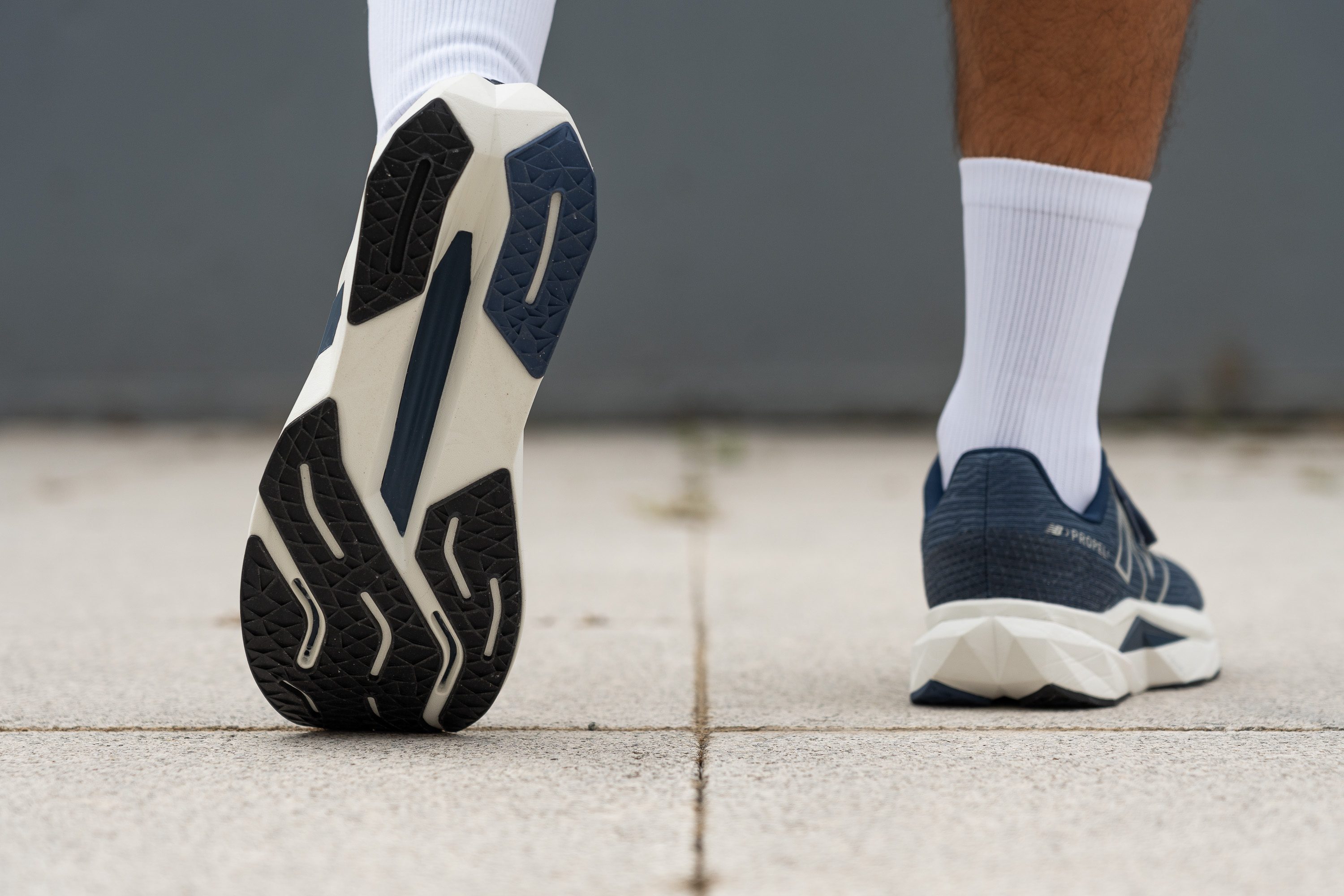
Flexibility / Stiffness
During our flex test—requiring a bend to 90 degrees—we noted that only 18.8N was needed, a decrease from the previous model's 24.4N.
This improvement highlights enhanced flexibility, making the shoe exceptionally suitable for everyday activities, whether it's a casual walk by the lake or a quick trip downtown to get some tasty ice cream!
This test follows an older methodology, which is why you don't see recently tested shoes in the chart. Results from different methodologies can not be compared.
| FuelCell Propel v5 | 18.8N |
| Average | 28.1N |
Stiffness in cold (%)
We repeated our 20-minute freezer test to assess the shoe's rigidity in extreme cold. Following the test, it required an additional 21.3% force to flex the shoe, which is a good outcome.
| FuelCell Propel v5 | 21% |
| Average | 33% |
Weight
The Propel v5 not only weighs under 10 oz, but it's also lighter than its predecessor.
Weighing in at just 9.5 oz (269g) on our scale, this weight is good considering its stack height and level of cushioning.
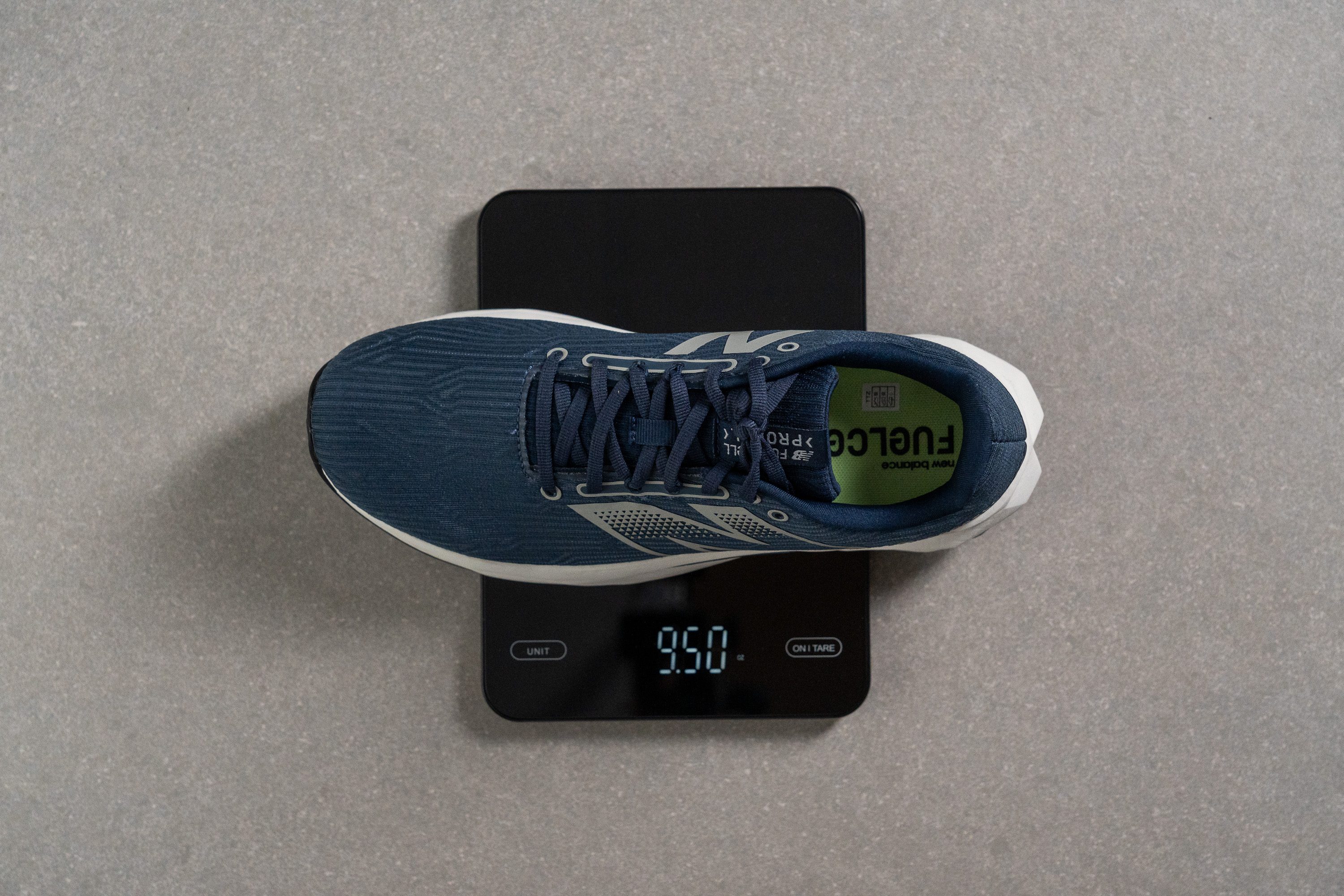
| FuelCell Propel v5 | 9.5 oz (269g) |
| Average | 9.3 oz (264g) |
Breathability
The noticeable differences between an affordable and a premium shoe often lie in the midsole or the upper. In this case, New Balance has incorporated the FuelCell midsole, indicating that savings were likely achieved in the upper to maintain the shoe's affordability.
Despite the cost savings, our smoke test revealed that breathability wasn't compromised—it actually excelled, scoring a perfect 5/5. It was impressive to see how effectively the shoe expelled smoke, showcasing exceptional airflow.
Understanding this shoe's excellent ventilation involved multiple testing, which prompted us to move the shoe over our powerful light. This revealed the Propel's highly breathable upper, featuring ventilation holes throughout the midfoot and forefoot.
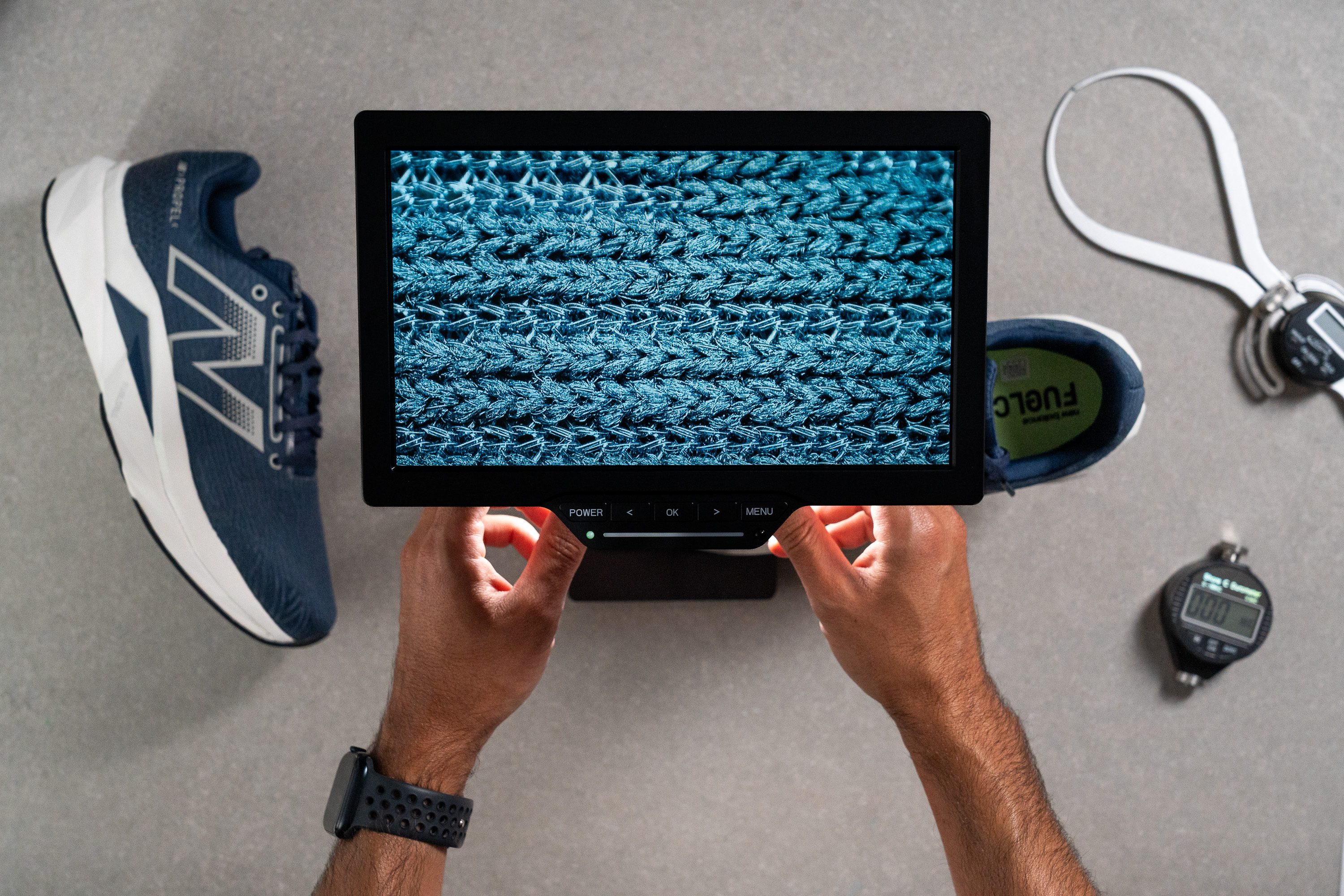
Under the microscope, the engineered mesh appeared standard, not particularly groundbreaking in terms of technical innovation, and maybe lacking in durability due to its thinness and lack of protective elements. We'll go into that in a minute.
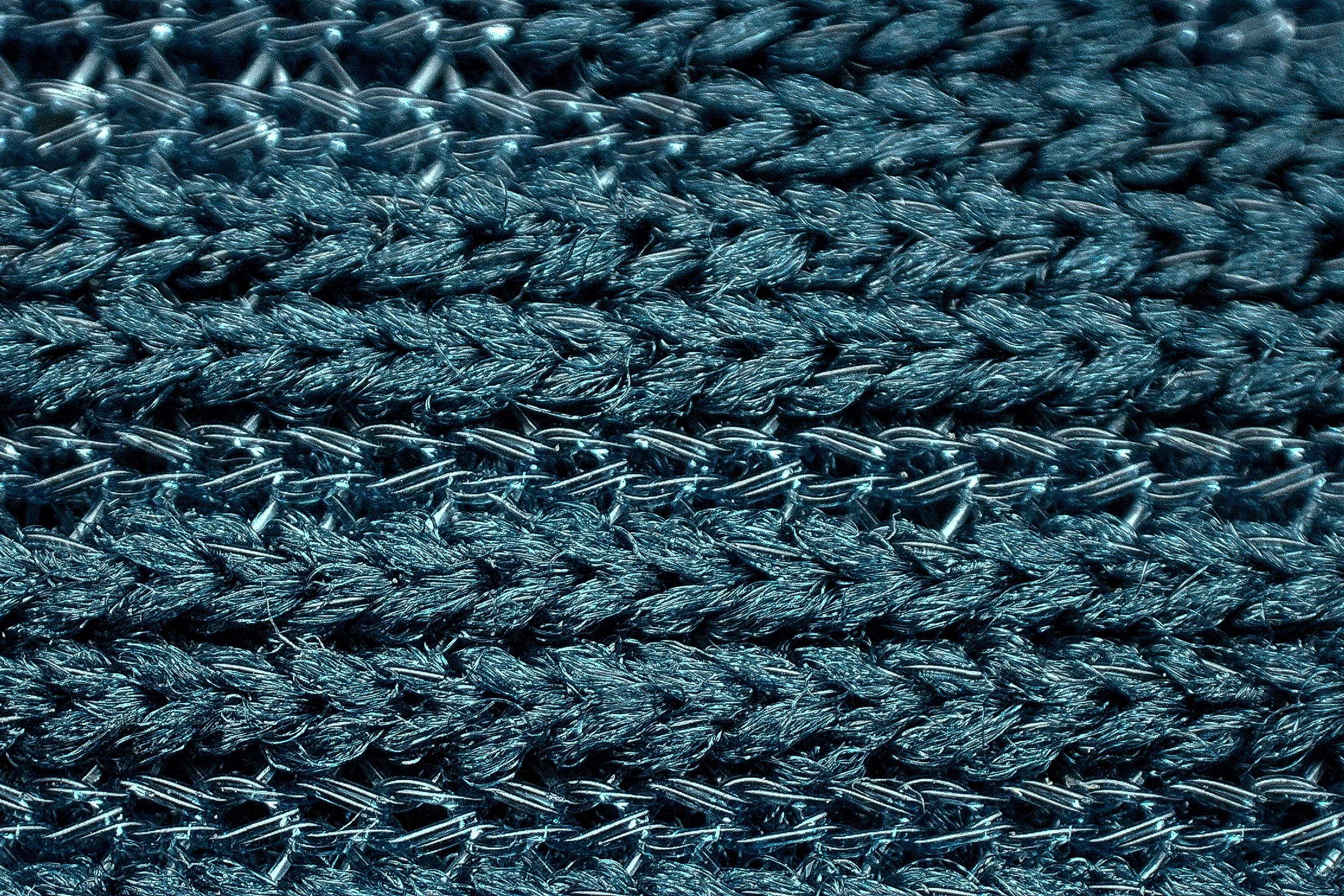
Upon manually examining the upper, we discovered that its design and construction are quite good for a shoe priced just over £100. However, we're still unsure about its durability, so let's get into that!
| FuelCell Propel v5 | 5 |
| Average | 3.7 |
Stability
Lateral stability test
Despite its partial-length TPU plate, we think the Propel v5 is only suited for neutral runners. We’ve determined this based on its ultra-soft FuelCell foam and midsole width. For runners needing more support, we recommend considering alternatives such as the Brooks Launch GTS 10.
Torsional rigidity
Given its TPU plate, scoring a 1 or 2 in this test seemed unlikely. However, we're satisfied with a score of 3, as we had concerns it might be too stiff like the previous version, which isn’t ideal for a versatile daily trainer. New Balance's subtle adjustment here is a welcome improvement for us.
| FuelCell Propel v5 | 3 |
| Average | 3.5 |
Heel counter stiffness
The heel counter earned a solid 3/5 regarding stiffness, and this wasn't surprising at all for us. It's a typical score for any daily driver, striking a good balance between comfort and support.
| FuelCell Propel v5 | 3 |
| Average | 2.9 |
Midsole width - forefoot
Turning our attention to the midsole's width, we recorded the forefoot at just 111.8 mm, which is a tiny bit narrower than the norm observed in our lab. This measurement, along with the softness of the foam, is a key reason why we don't recommend this shoe for those needing stability.
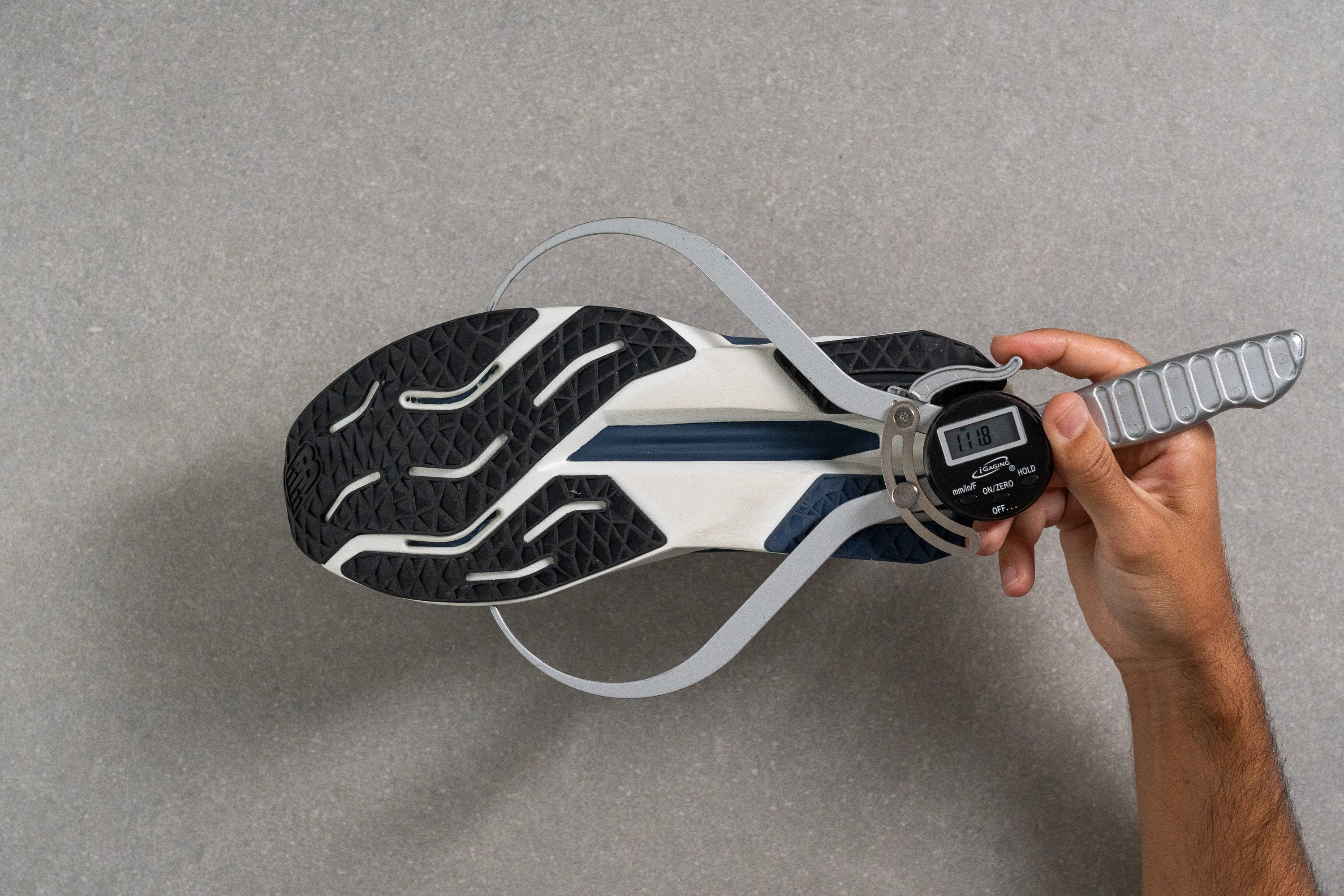
| FuelCell Propel v5 | 111.8 mm |
| Average | 114.4 mm |
Midsole width - heel
Similarly in the heel, the Propel v5 measures at 89.1 mm, hovering near the average. This dimension confirms it as a strong option exclusively for neutral runners.
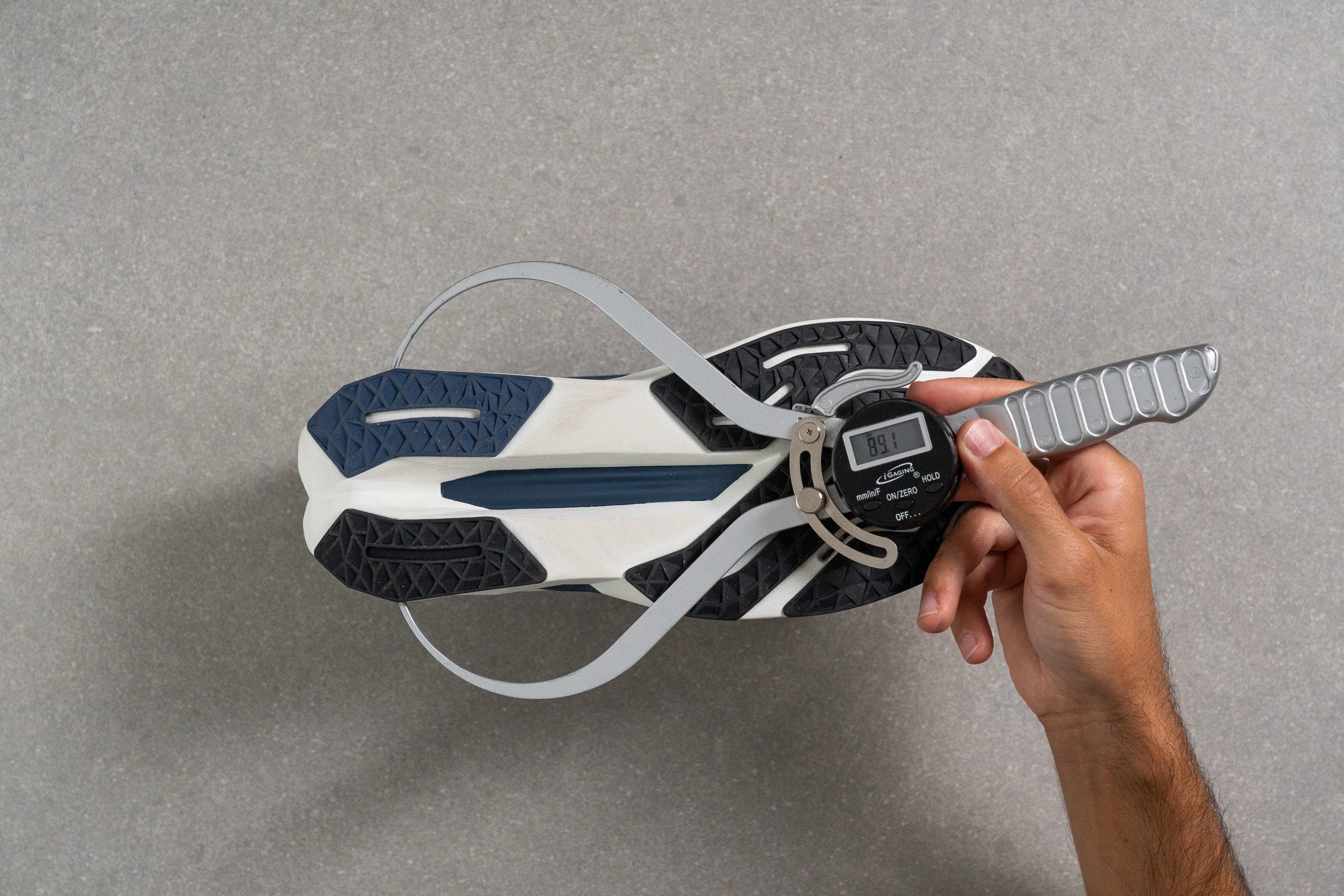
| FuelCell Propel v5 | 89.1 mm |
| Average | 90.7 mm |
Durability
Toebox durability
After handling hundreds of shoes in our lab and testing their uppers against the Dremel, we've developed a great instinct for predicting outcomes. Unfortunately, we anticipated that the Propel v5 would not fare well in this test.
True to our suspicions, the Propel v5 quickly died—its outstanding breathability and the absence of protective elements led it to a dismal score of 1/5.
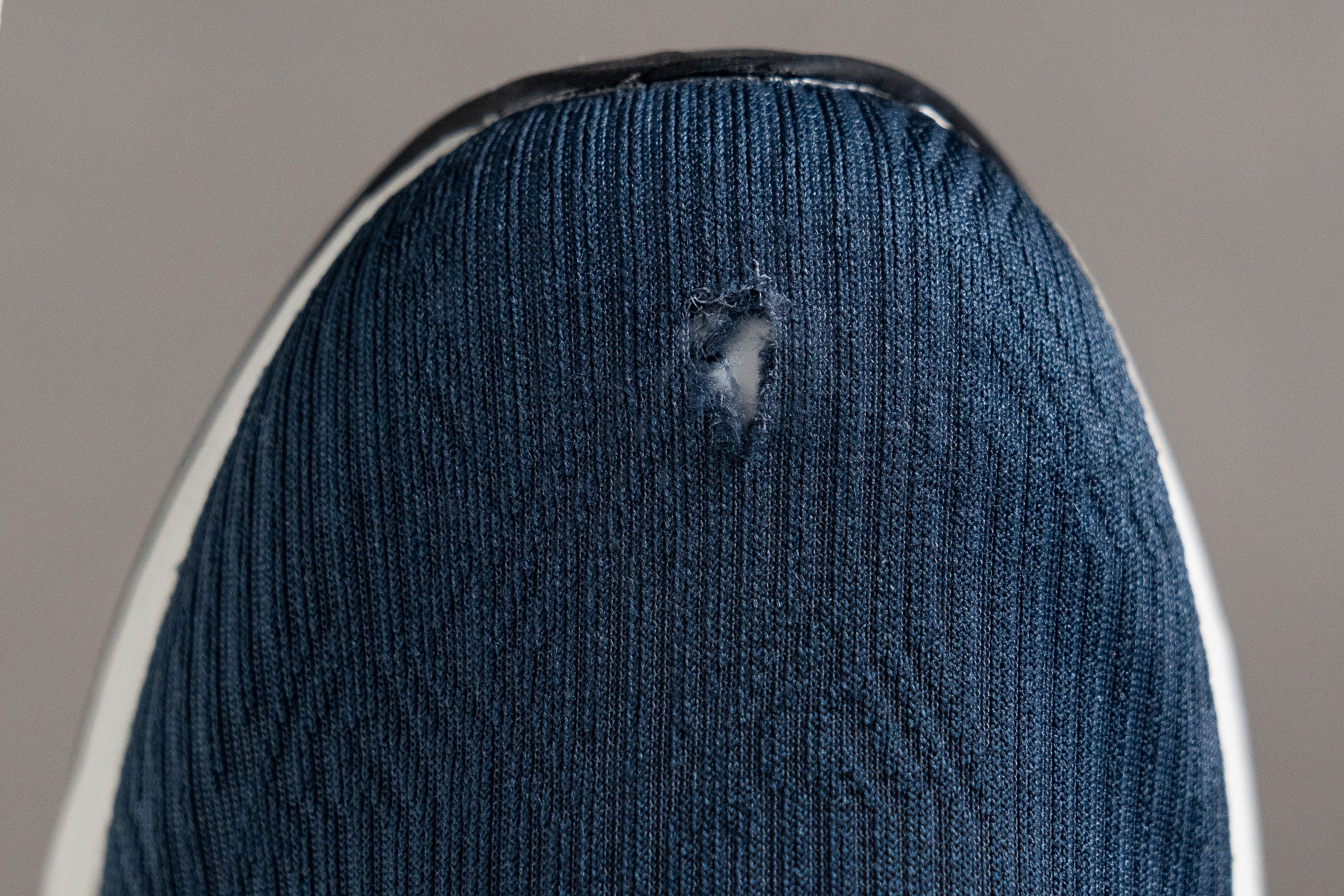
| FuelCell Propel v5 | 1 |
| Average | 2.6 |
Heel padding durability
While the initial disappointment was somewhat anticipated and isn't rare in road running shoes, our next finding was more troubling.
We encountered another score of 1/5, and this one caught us off guard. Therefore, those who frequently experience wear and tear in this area should definitely steer clear of the Propel v5.
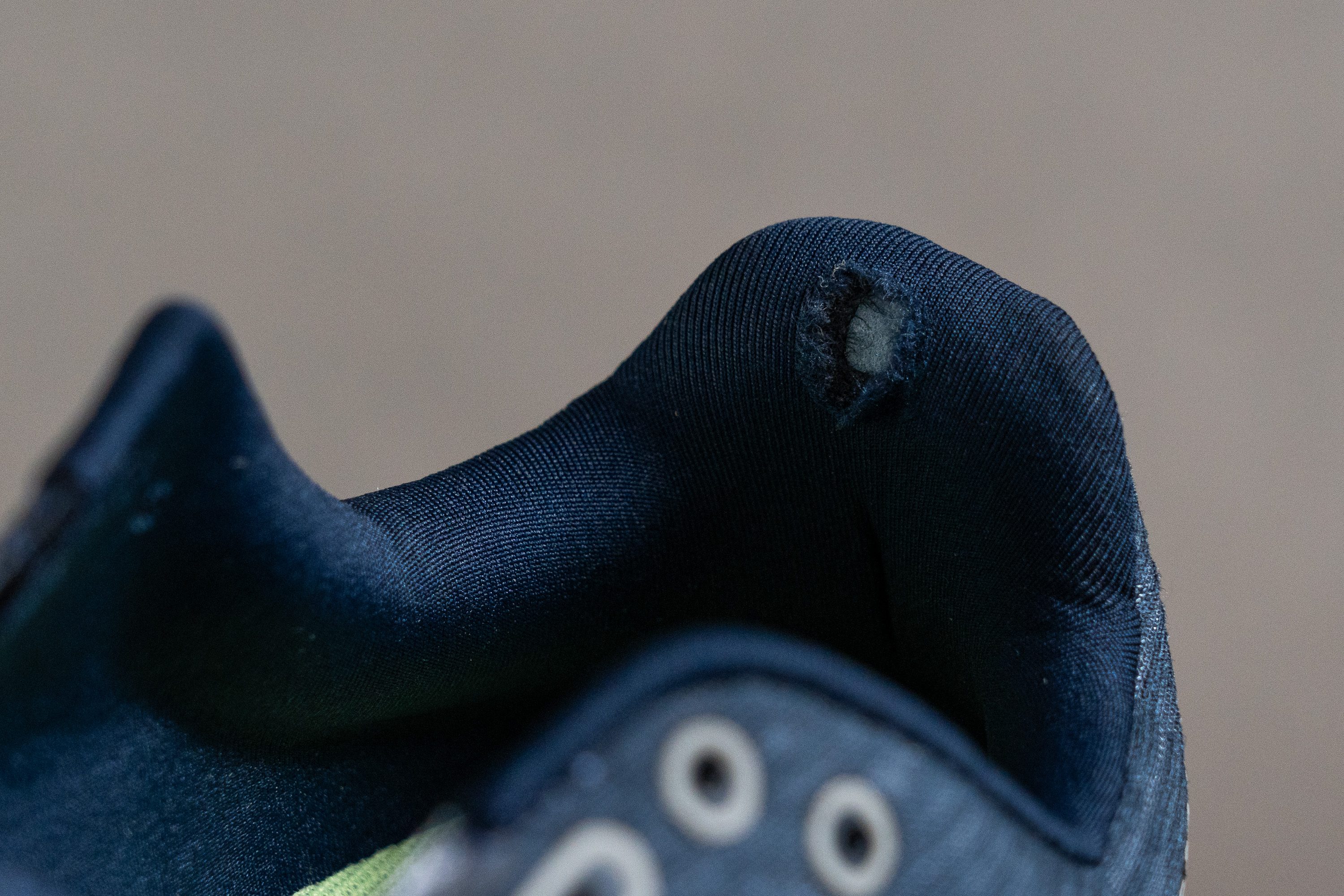
| FuelCell Propel v5 | 1 |
| Average | 3.4 |
Outsole hardness
We moved on to the outsole with high hopes for improvements. Initially, we noticed that New Balance continues to replicate its design approach within the Propel series—they just craft a more economical version of their high-end models.

Just as the Propel v4 mimicked the SC Trainer v2, the Propel v5 adopts the midsole and outsole design from the SC Trainer v3, including the distinctive central groove that showcases the TPU plate.
Regarding the rubber, it's a standard compound that registered at 78.3 HC on our tests. It provides adequate grip but isn't exceptional.
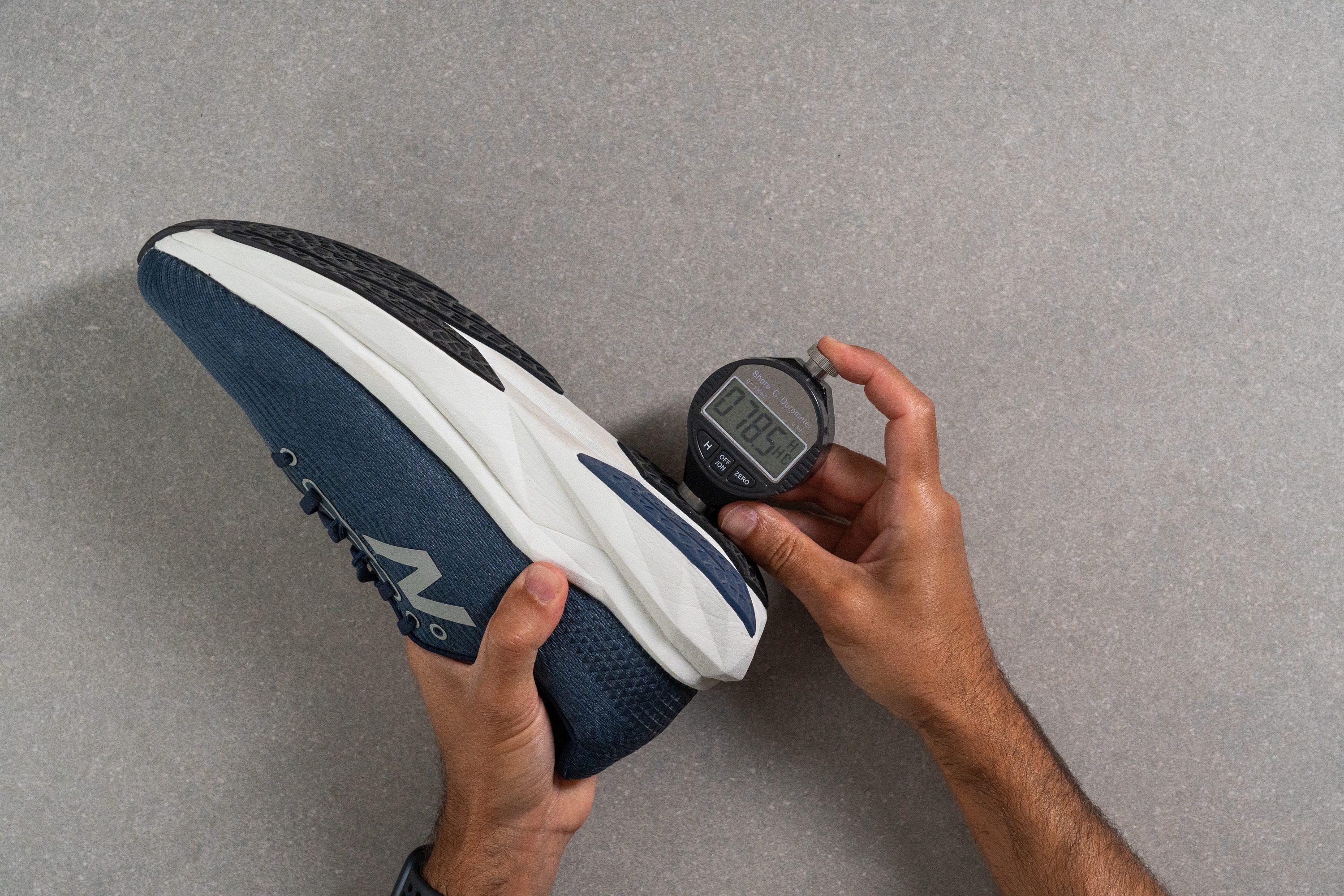
| FuelCell Propel v5 | 78.3 HC |
| Average | 79.2 HC |
Outsole durability
It seemed unlikely the outsole could perform worse than the upper—and fortunately, it didn’t.
The results were notably better, though still not at the level of leading competitors like the ASICS Jolt 4. We measured a 1.1 mm indentation in the rubber, erasing major concerns but indicating there's still room for enhancement.
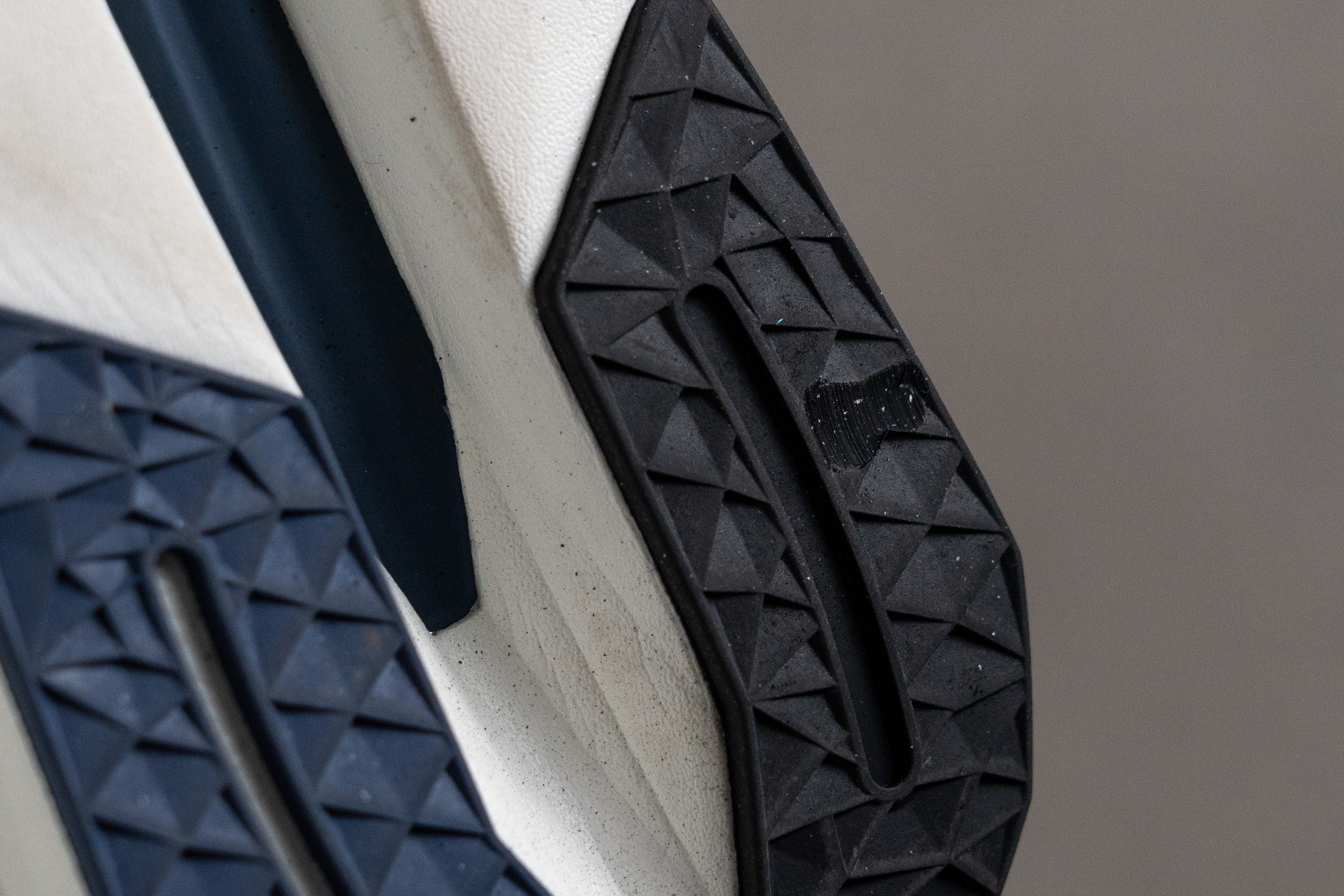
| FuelCell Propel v5 | 1.1 mm |
| Average | 1.1 mm |
Outsole thickness
We measured the thickness of the Propel's outsole at 3.2 mm using our callipers. We believe this offers substantial protection for the midsole, and based on our durability testing, we're confident it's adequate for regular use.
However, we recommend avoiding gravel roads with this shoe. The outsole's central groove is not well-suited for such surfaces, making it a better option for regular roads or well-maintained groomed trails.
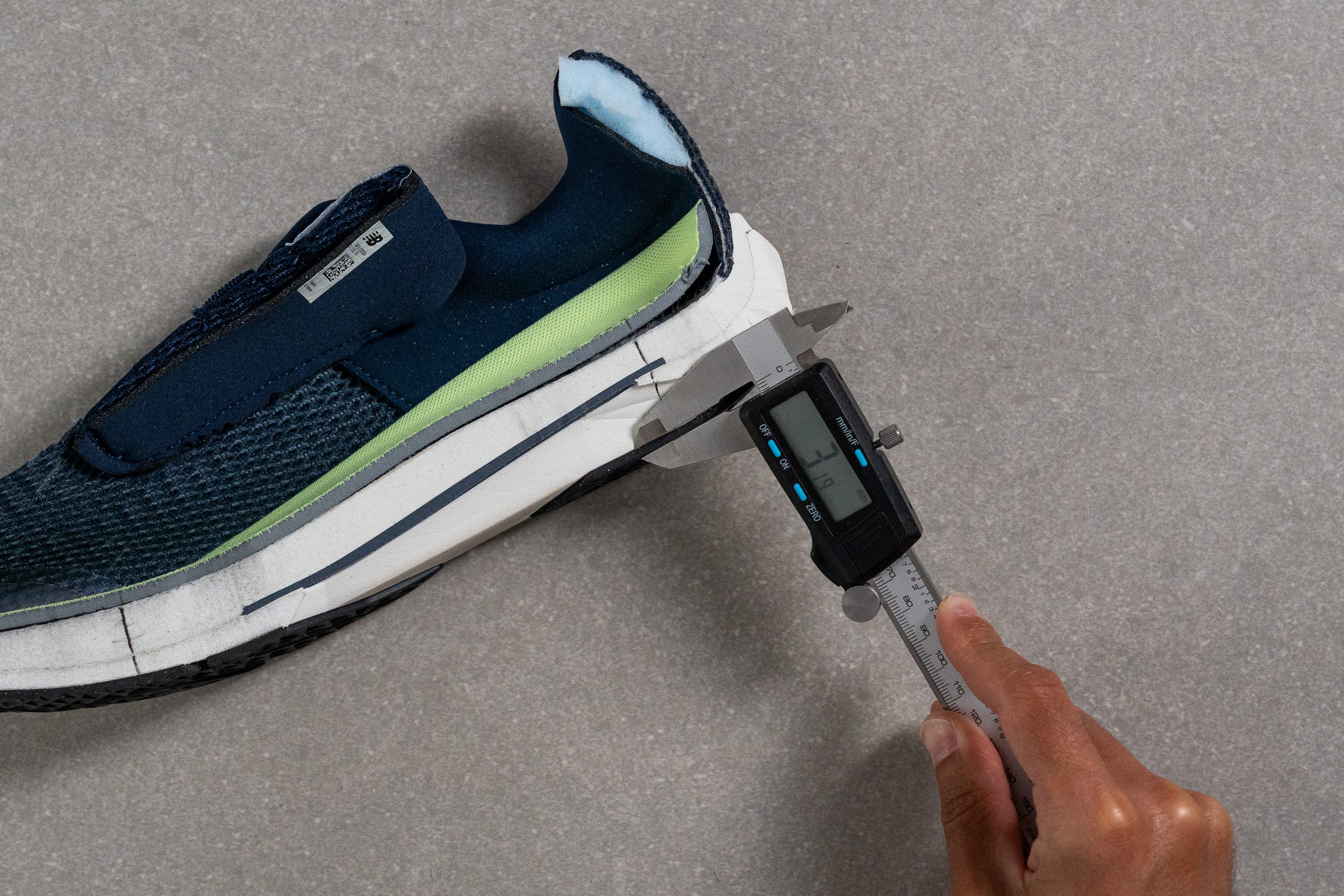
| FuelCell Propel v5 | 3.2 mm |
| Average | 3.2 mm |
Misc
Insole thickness
At 4.1 mm thick, the insole of the Propel v5 has a straightforward design.
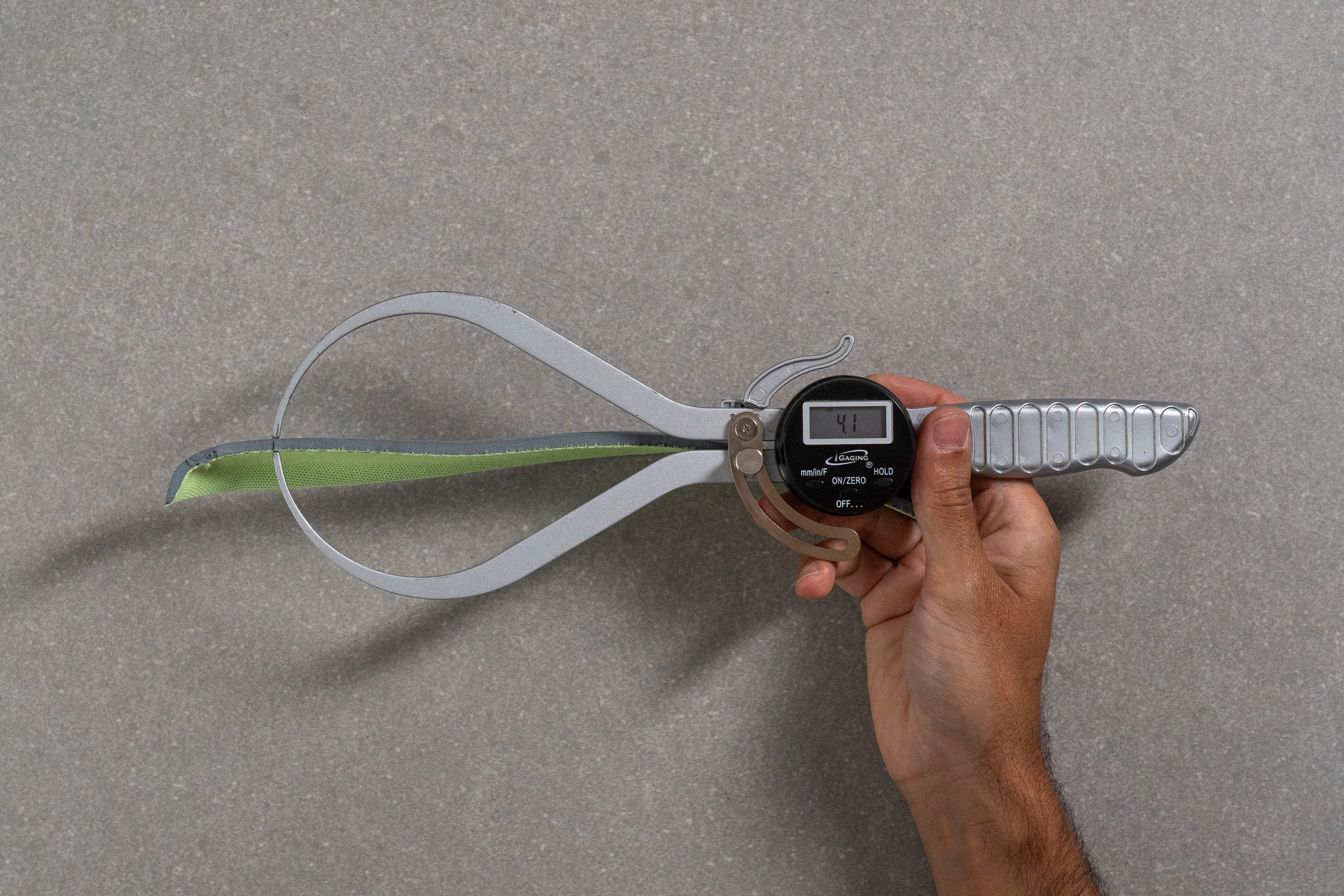
| FuelCell Propel v5 | 4.1 mm |
| Average | 4.5 mm |
Removable insole
We easily swapped the insole for a third-party footbed of our choice, as the shoe’s dimensions and shape are quite standard.
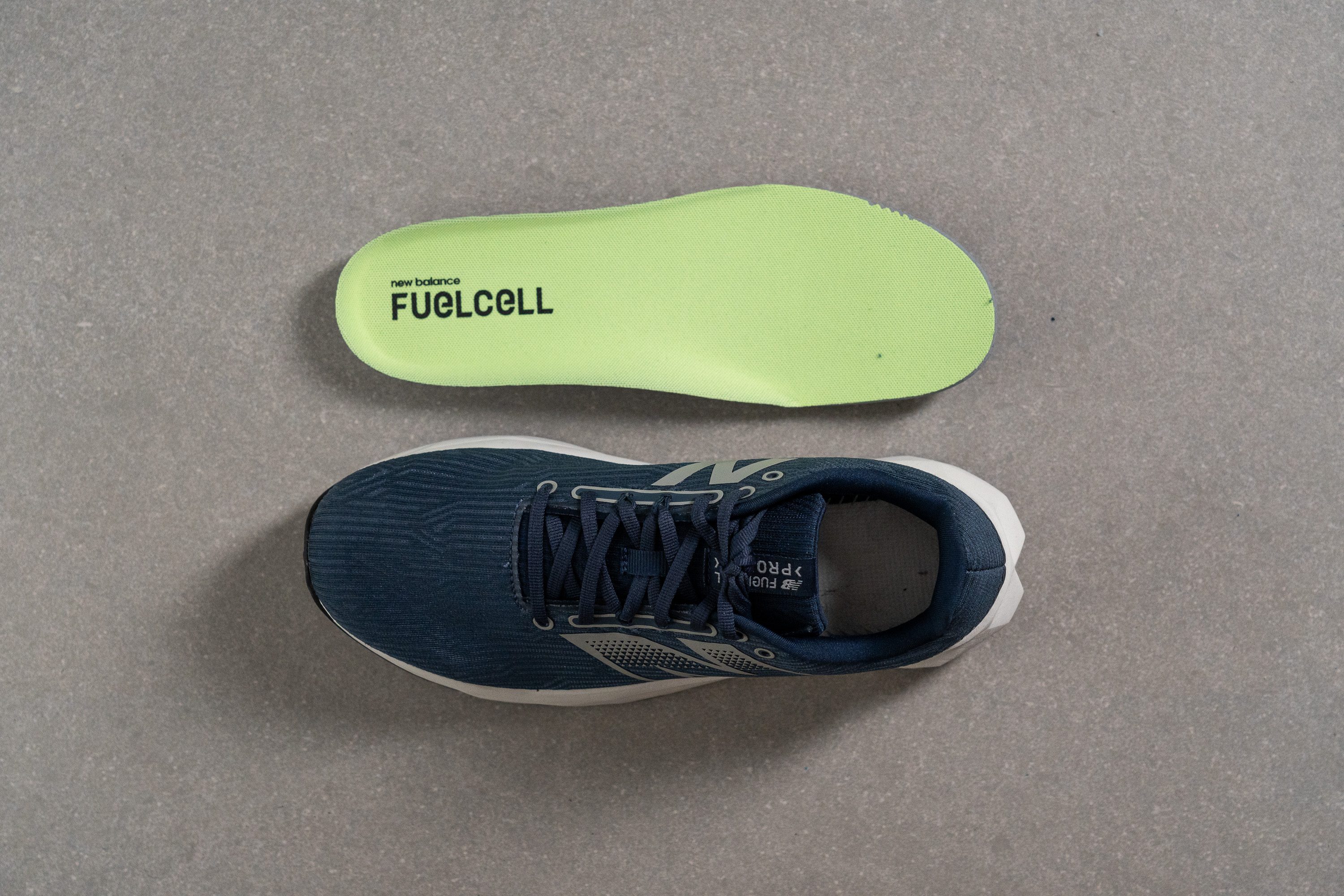
| FuelCell Propel v5 | Yes |
Midsole softness in cold
We discovered that the tongue is not attached to the sides, which was somewhat expected yet still feels a bit like a missed opportunity. Nonetheless, it includes a loop that effectively centres the tongue and prevents it from shifting during fast-paced runs.
| FuelCell Propel v5 | 13.6 HA |
| Average | 25.2 HA |
Midsole softness in cold (%)
Given that this variation of FuelCell is primarily EVA, we anticipated challenges during our cold weather test. We subjected the shoe to 20 minutes in a freezer and then assessed its softness again. Indeed, the result increased by 39.7%, a significant jump, yet it left the shoe still plush at 13.6 HA.
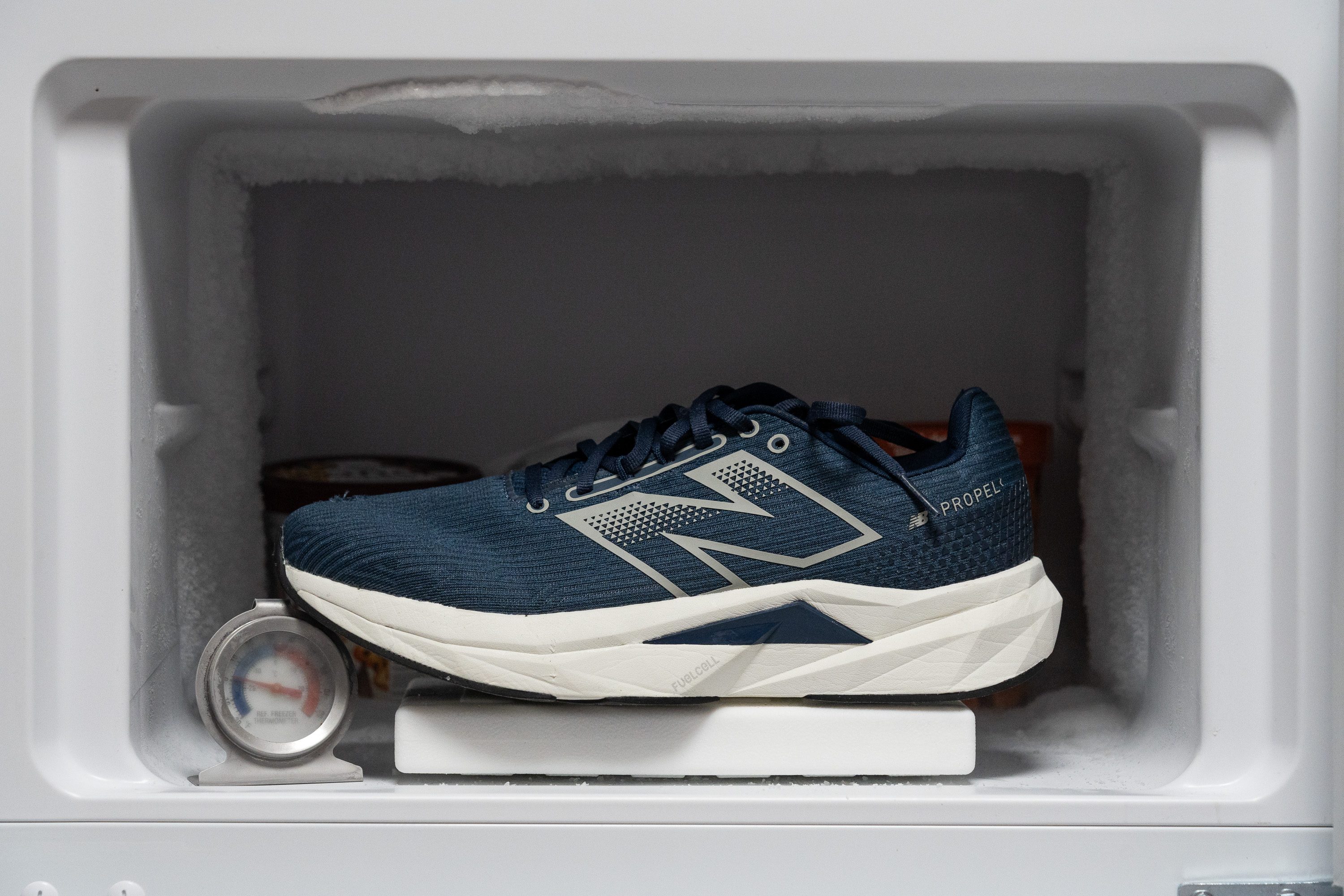
| FuelCell Propel v5 | 40% |
| Average | 24% |
Reflective elements
We understand New Balance's decision to reserve reflective elements for their premium models, and this is not one of them.
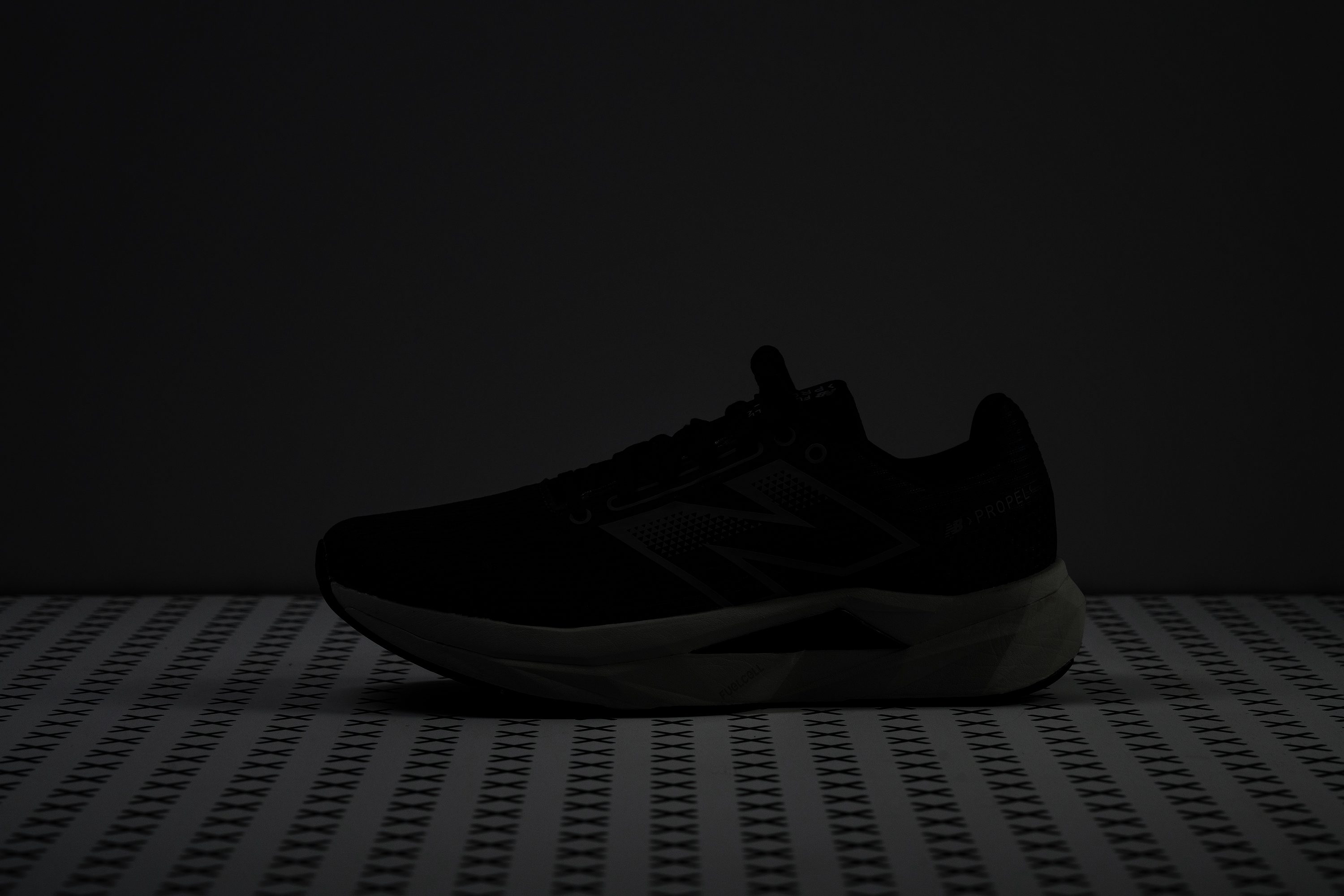
| FuelCell Propel v5 | No |
Tongue padding
In our lab, we typically encounter either paper-thin or excessively plush tongues in running shoes, but it's rare to find a brand that strikes a balance between weight and comfort. New Balance has managed to do exactly that with the Propel v5, featuring a 5.6 mm tongue that is both comfortable and lightweight.
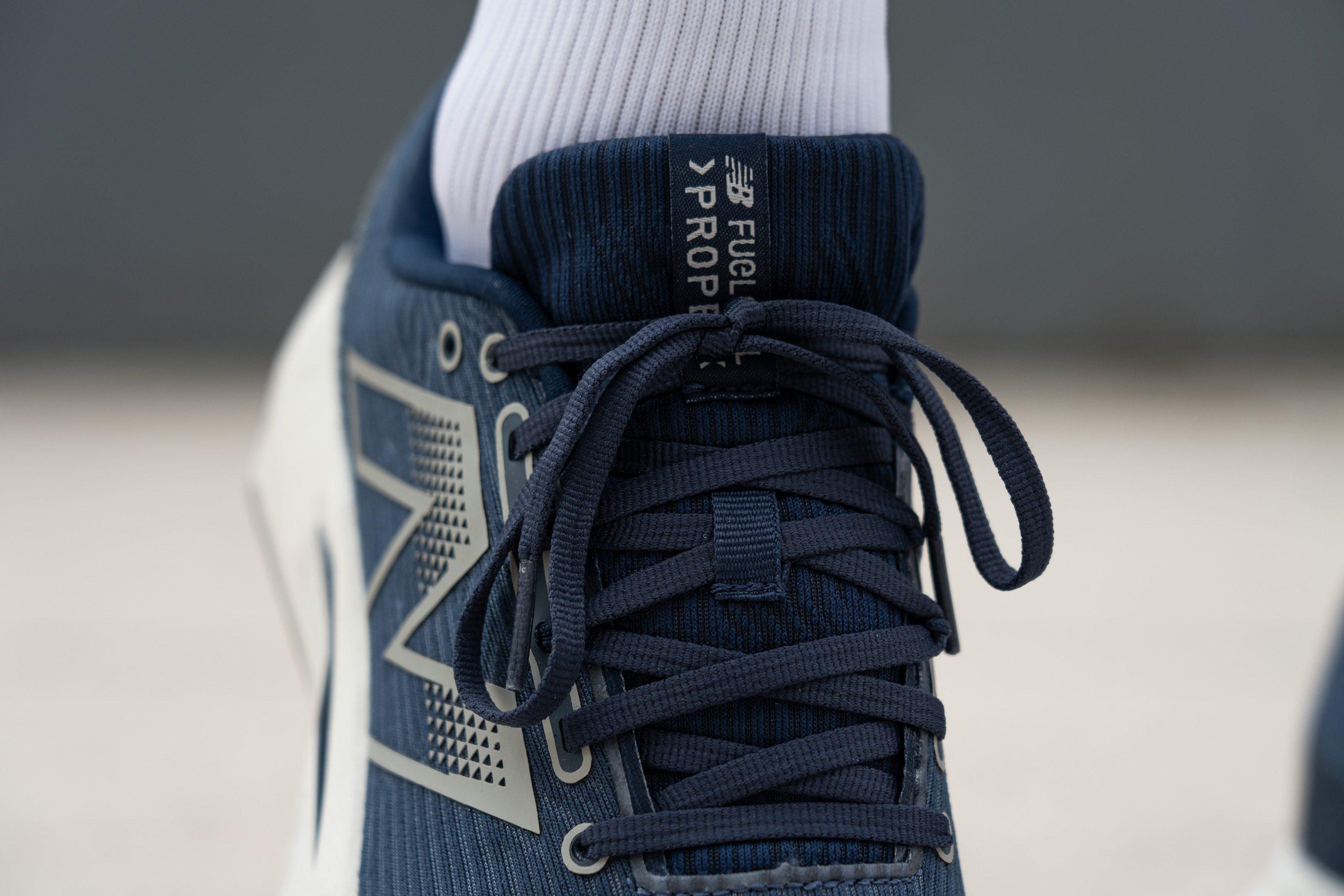
We were also impressed with the simple lacing system that utilises punched eyelets, a straightforward and cost-effective design approach that many brands unnecessarily complicate. The lockdown is solid, and the laces thread smoothly. We loved it.
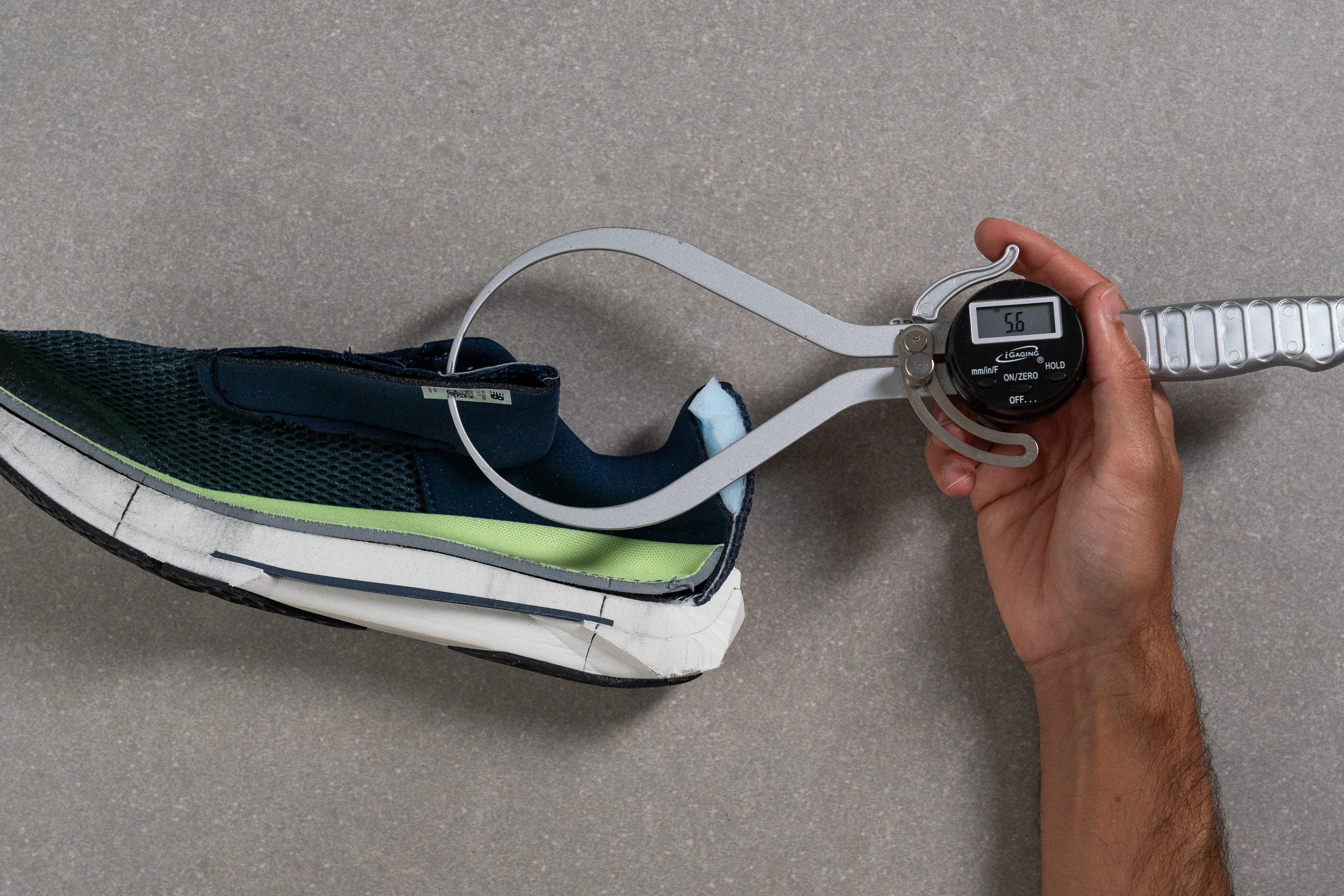
| FuelCell Propel v5 | 5.6 mm |
| Average | 5.8 mm |
Tongue: gusset type
We discovered that the tongue is not attached to the sides, which was somewhat expected yet still feels a bit like a missed opportunity. Nonetheless, it includes a loop that effectively centres the tongue and prevents it from shifting during fast-paced runs.
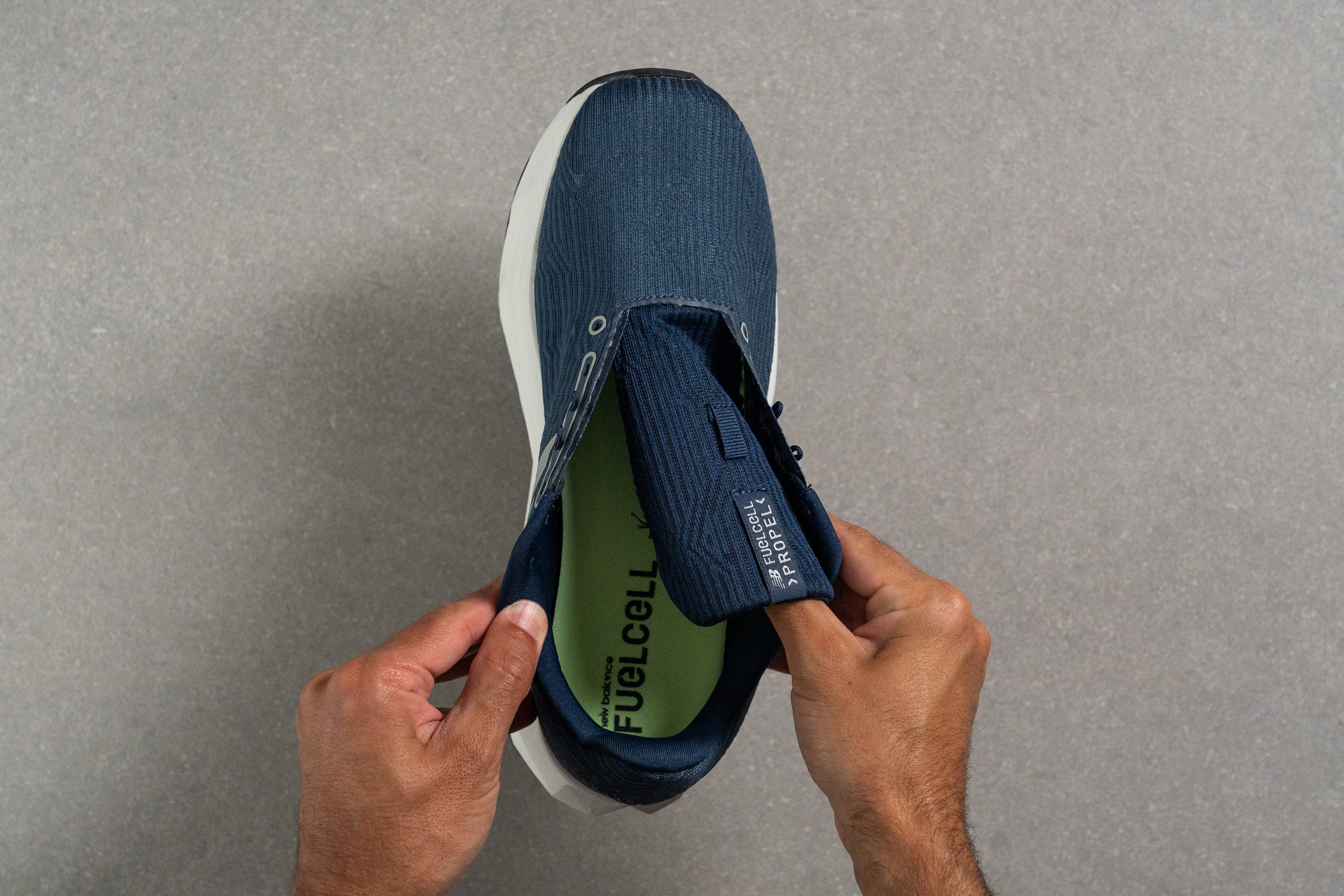
| FuelCell Propel v5 | None |
Price
The New Balance FuelCell Propel v5 sees a minor increase from its previous version—a hike we hadn't expected. However, it remains competitively priced within the mid-tier range.
We feel that it offers great value, particularly for those who don't wear through shoes quickly. And it stands as a formidable alternative to more expensive daily trainers like the Nike Pegasus 41.
| FuelCell Propel v5 | $120 |
Heel tab
All of New Balance's road running releases so far in 2024, including the Propel v5, lack a heel tab. And while we appreciate having something to pull on, its absence isn't a deal-breaker by any means.
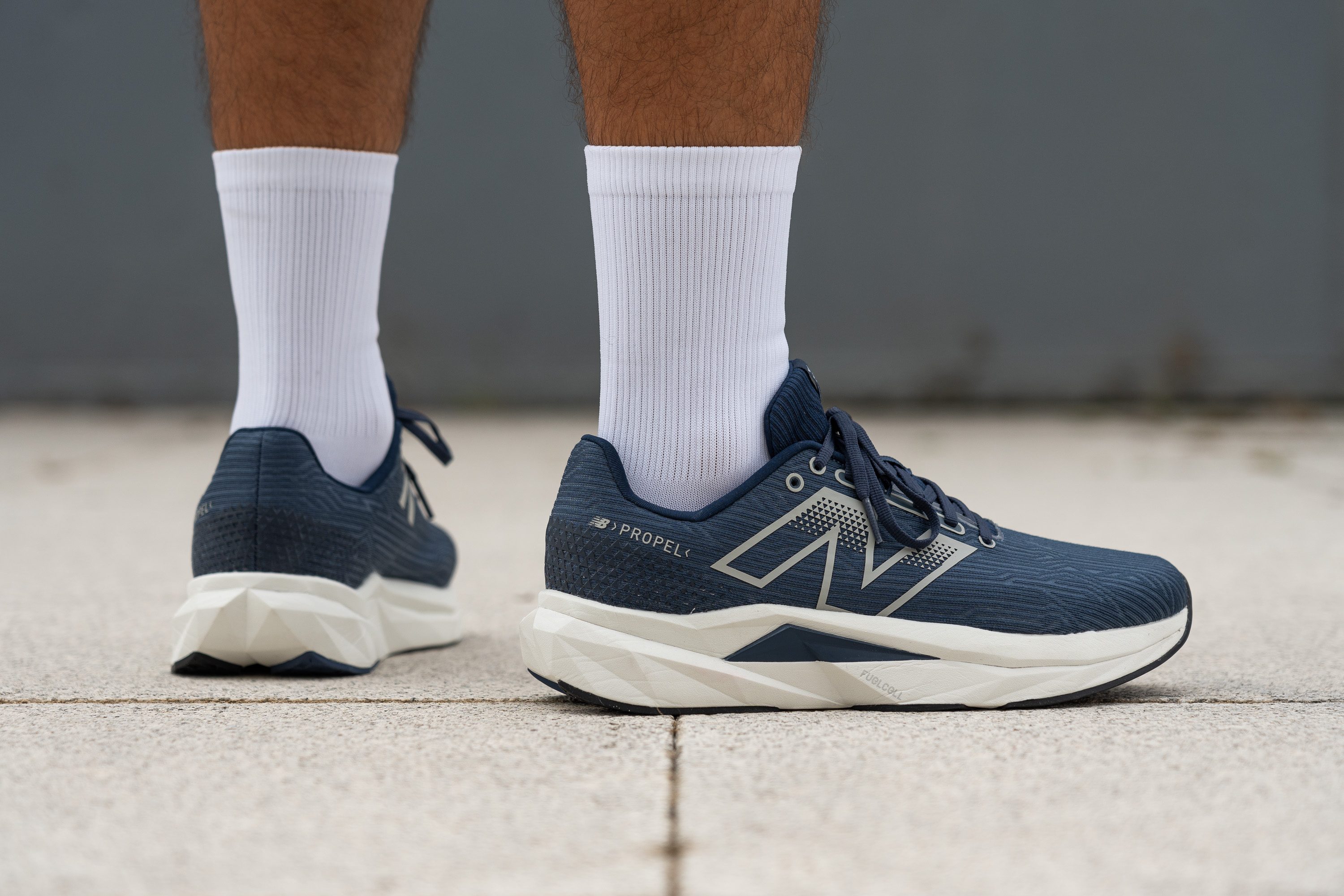
| FuelCell Propel v5 | None |

